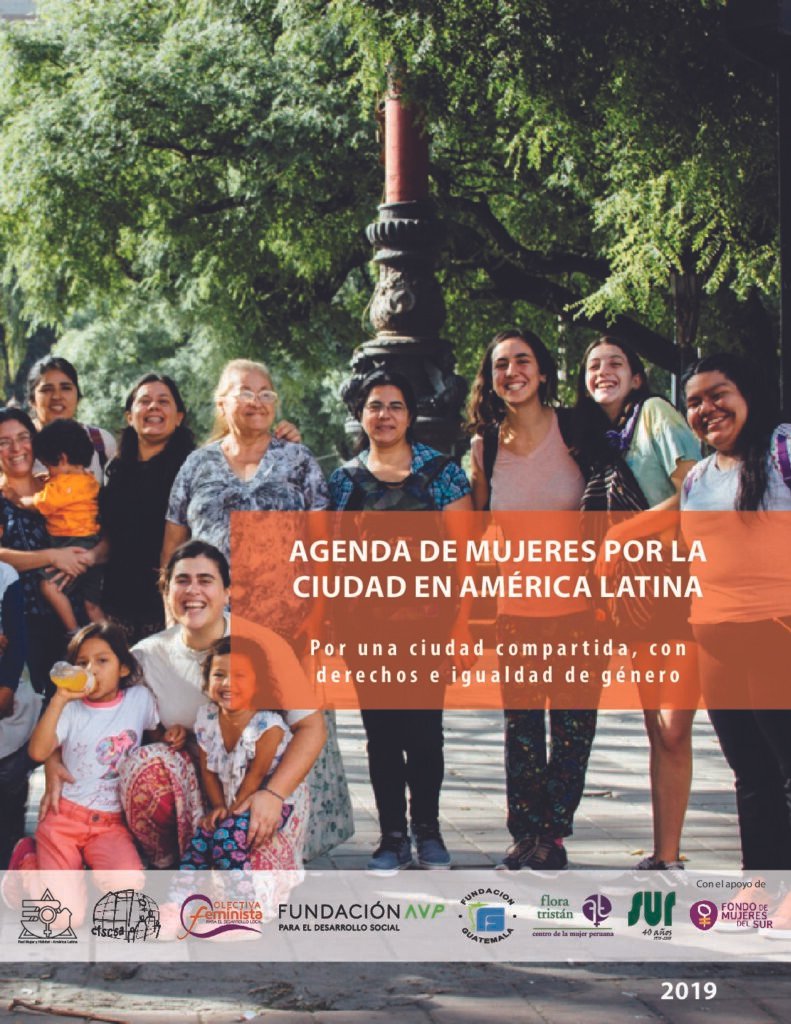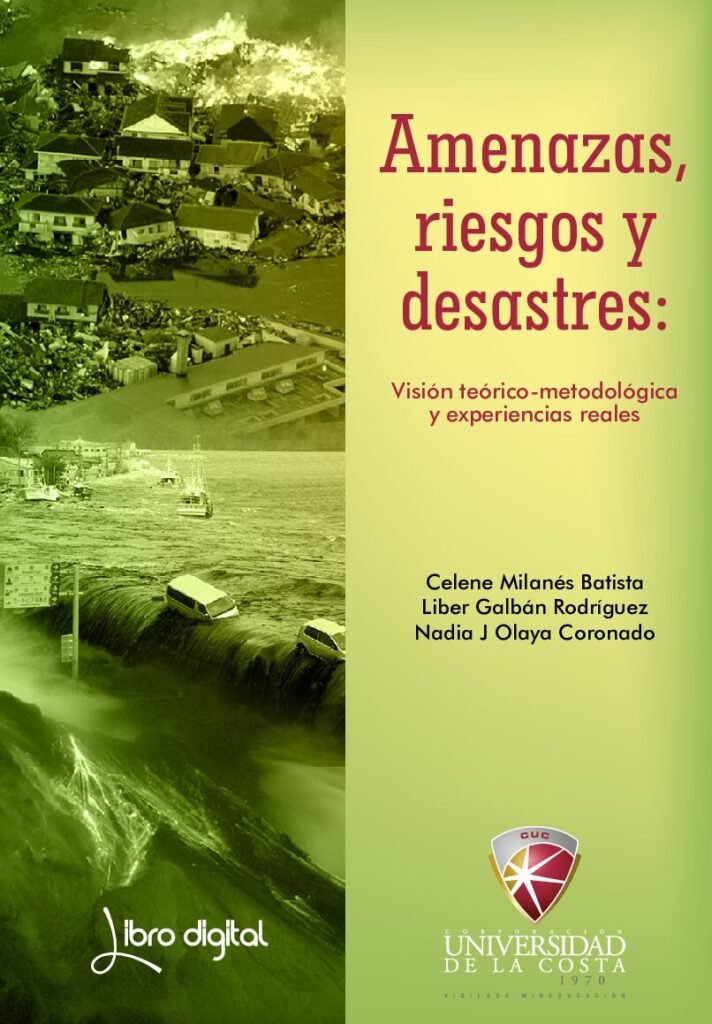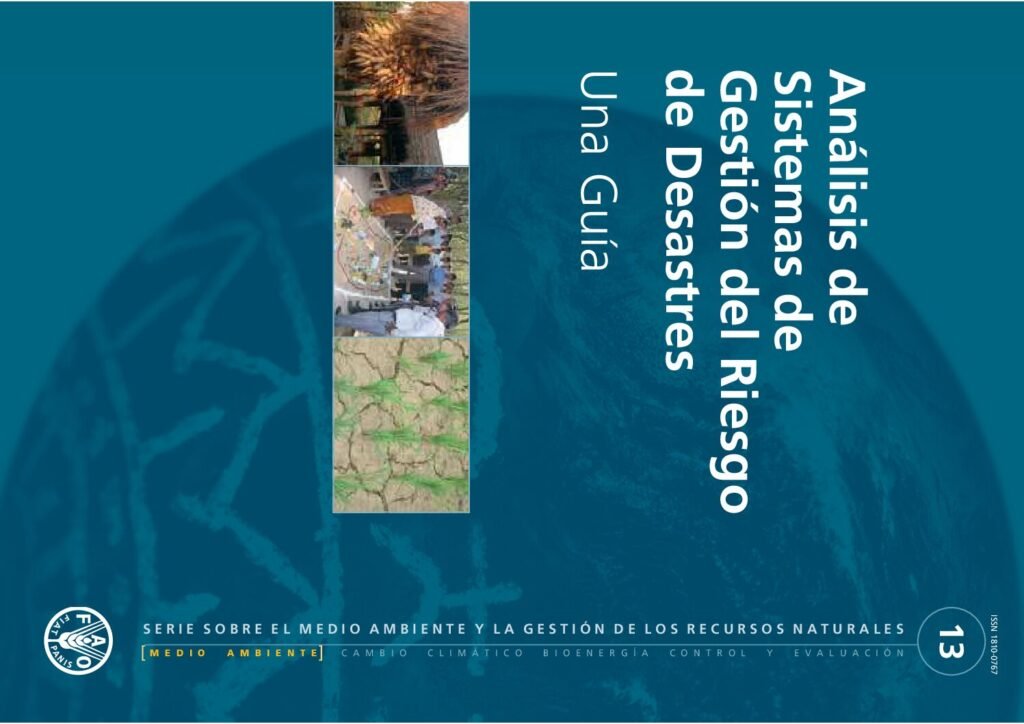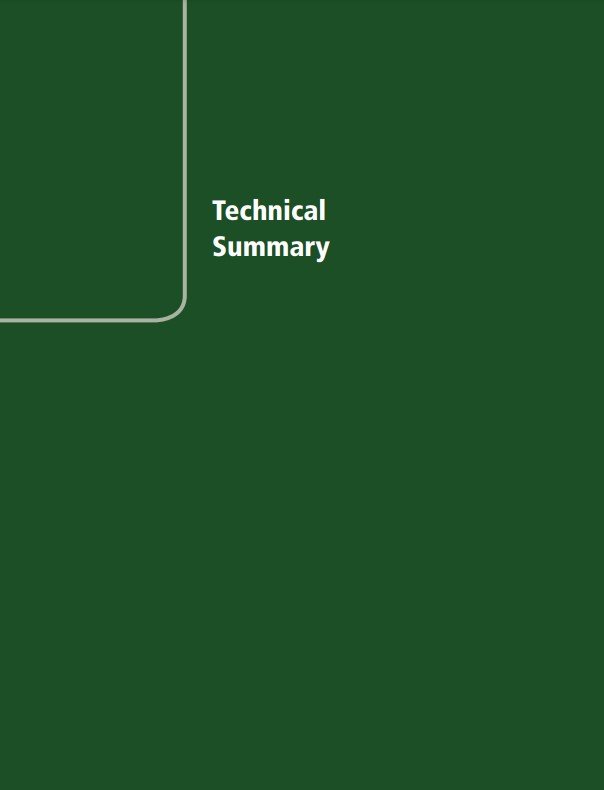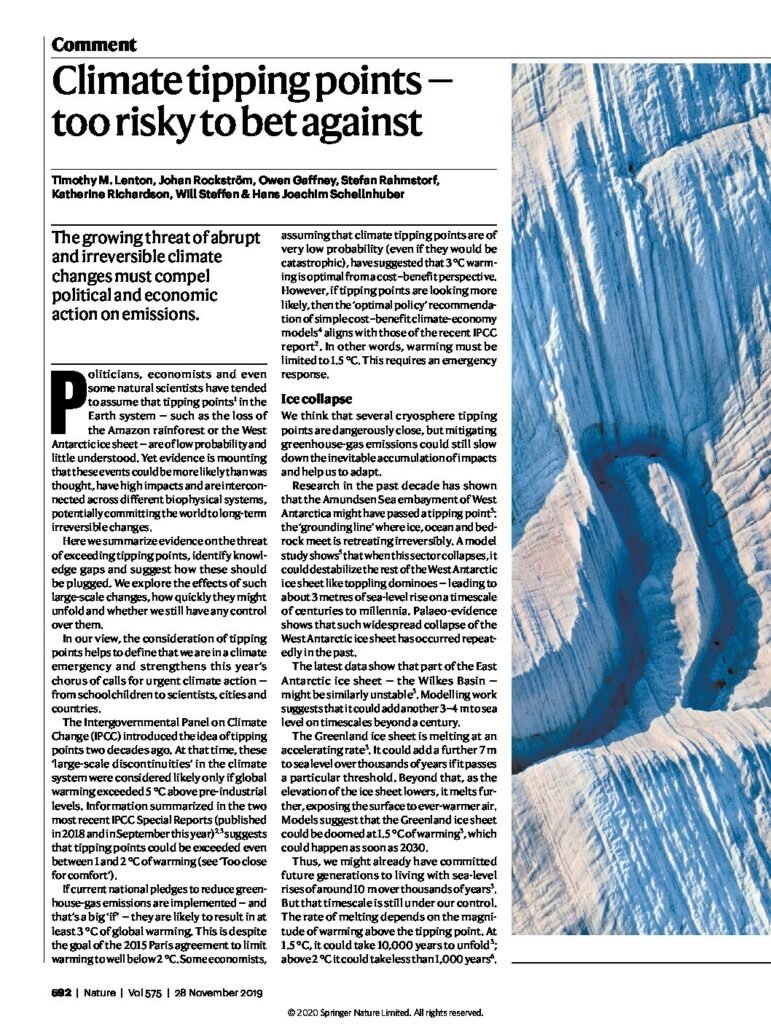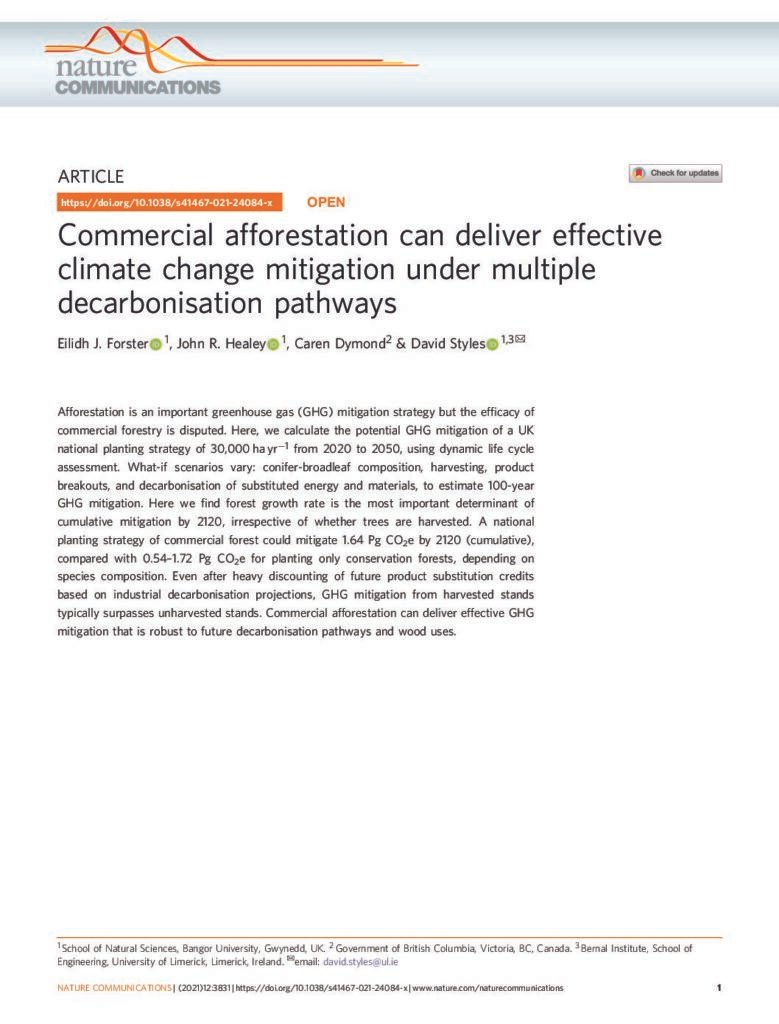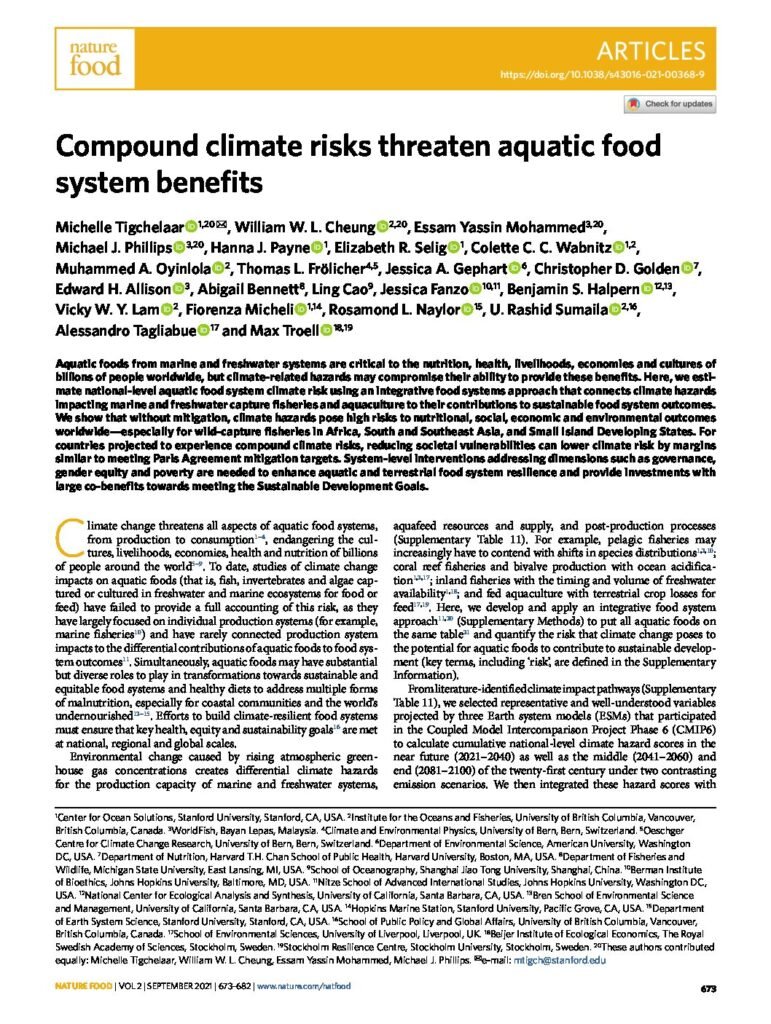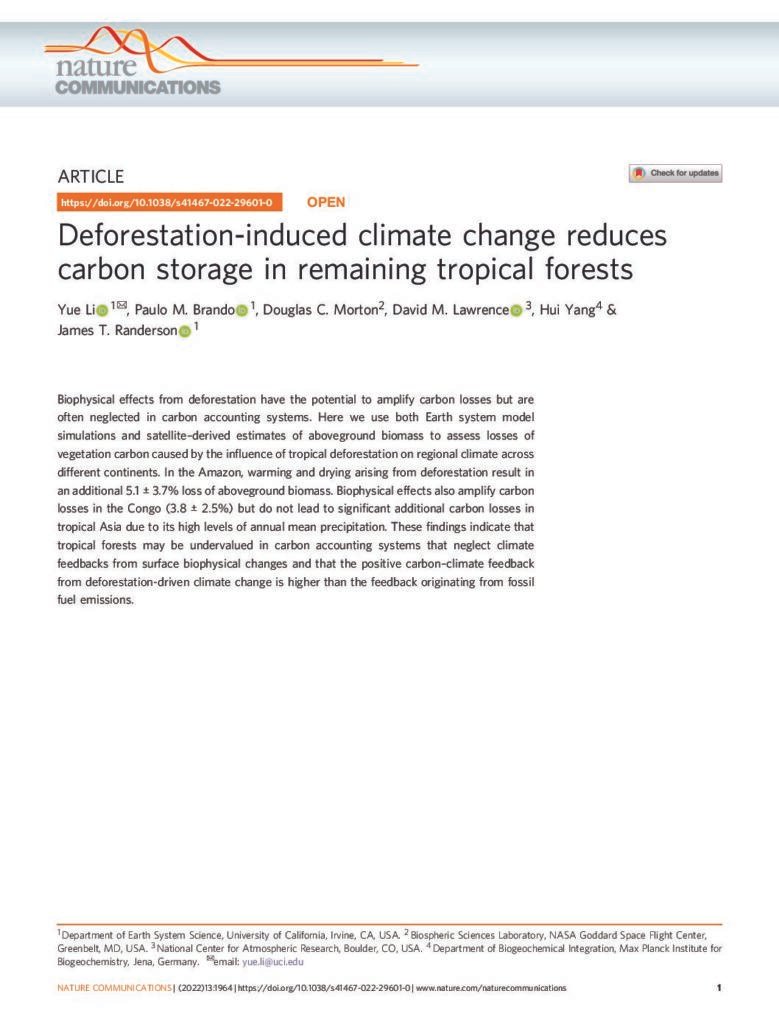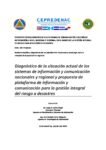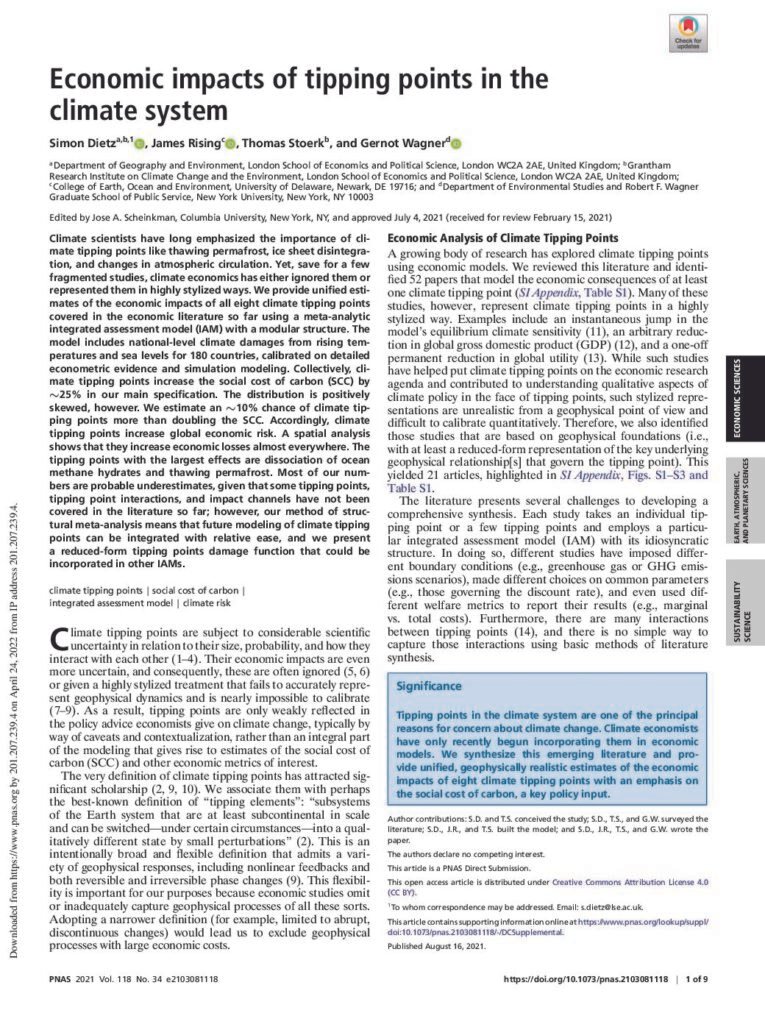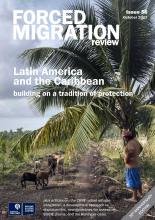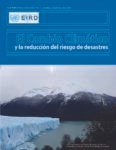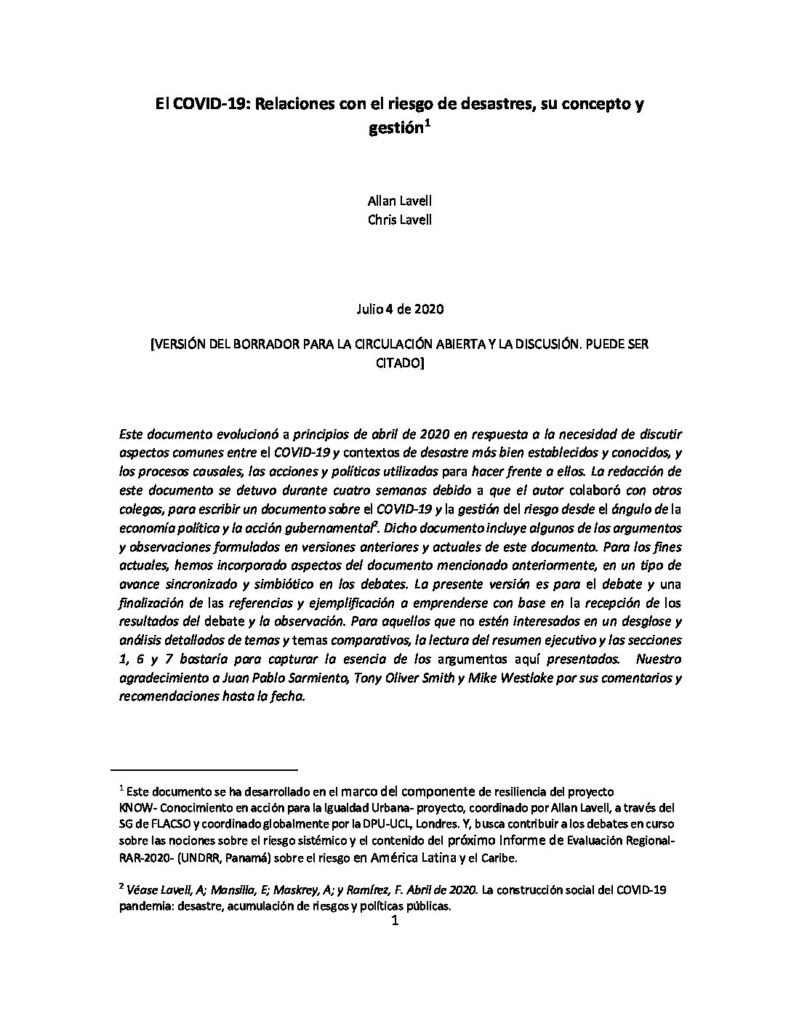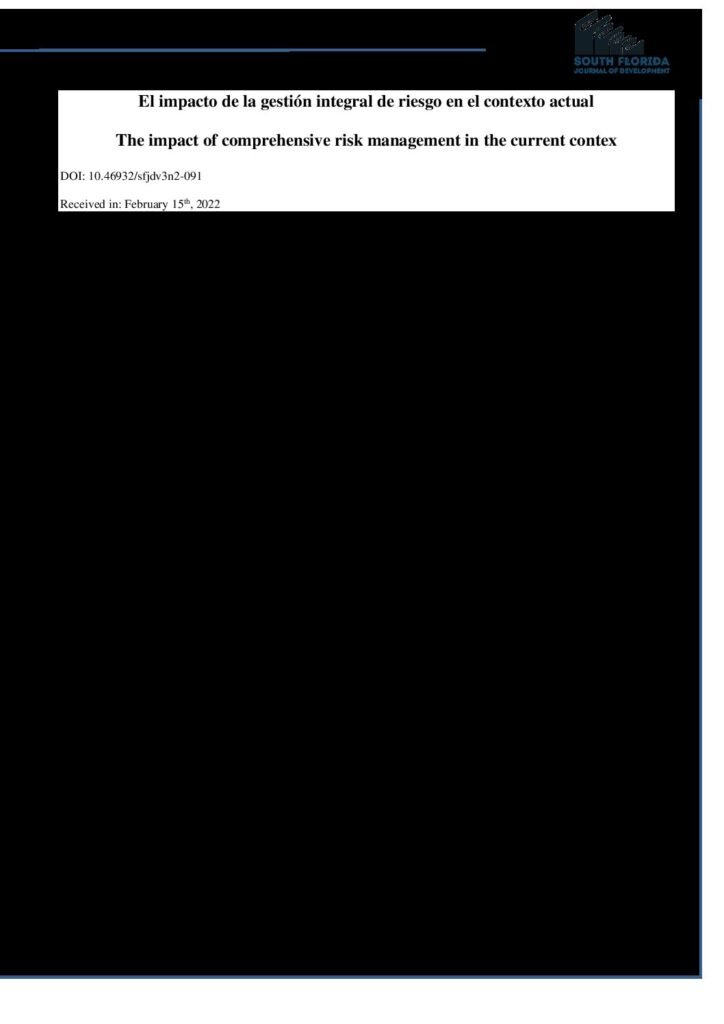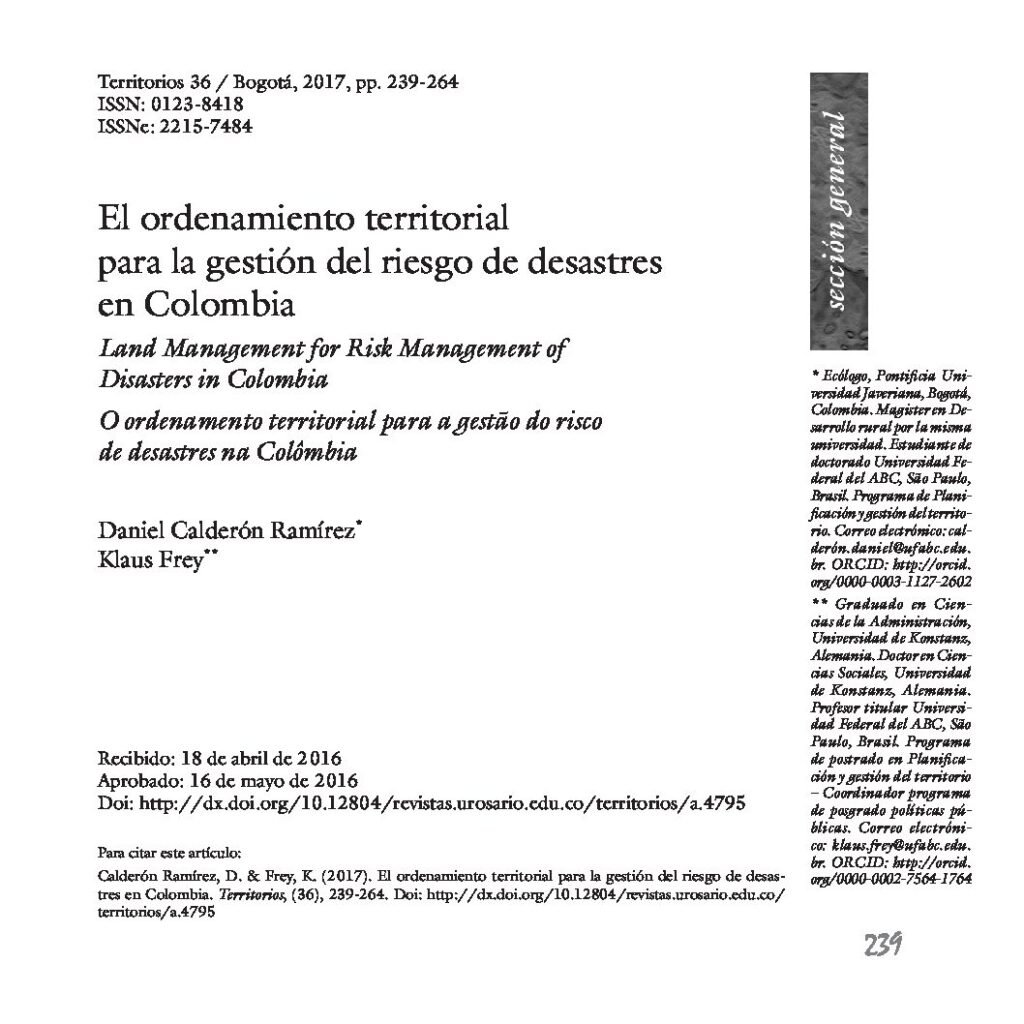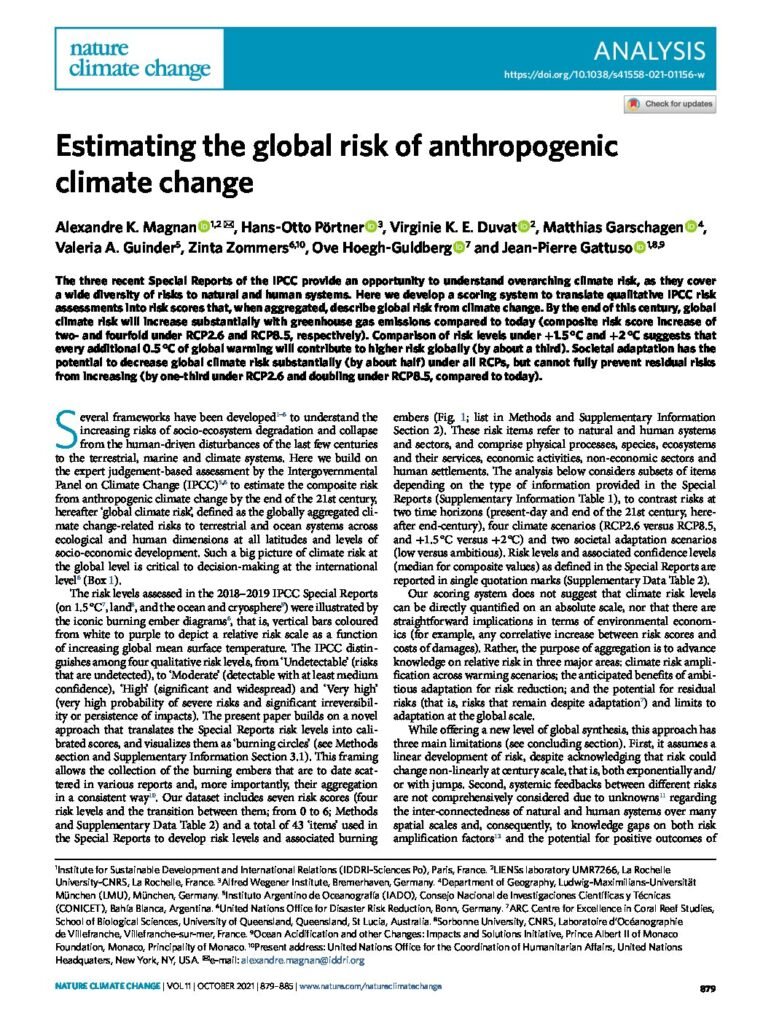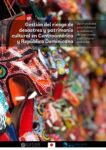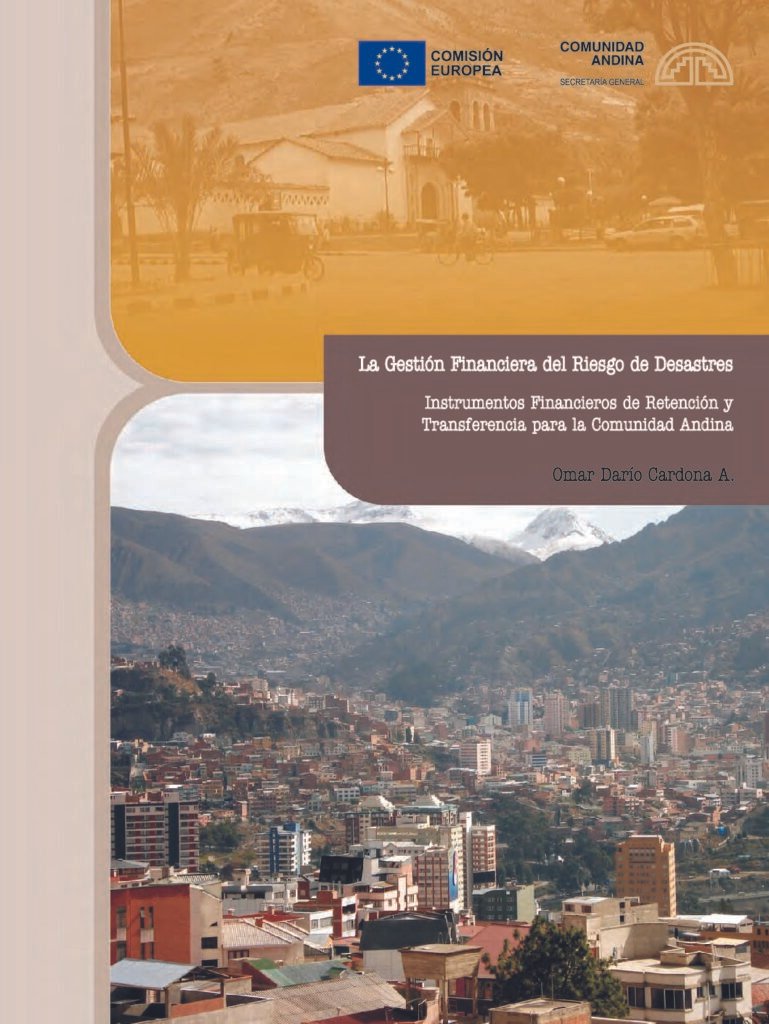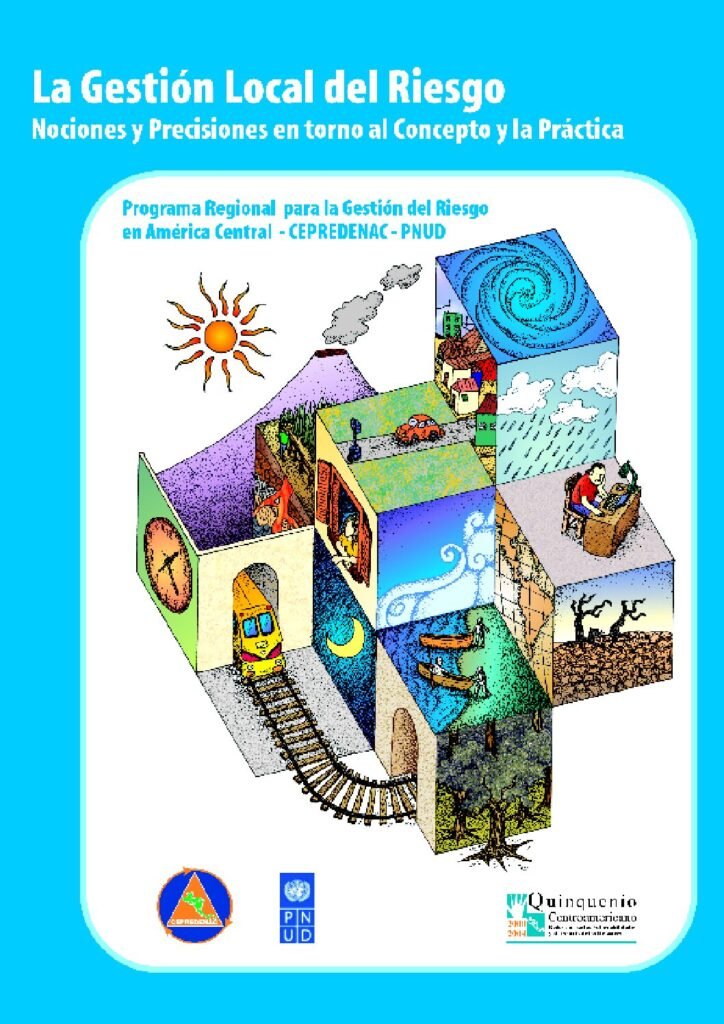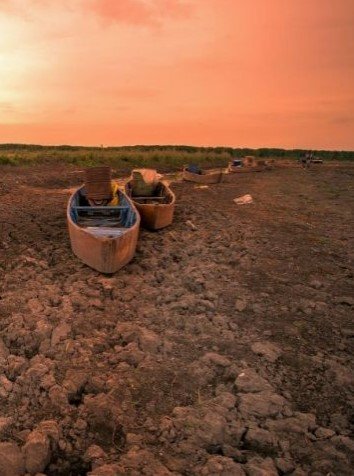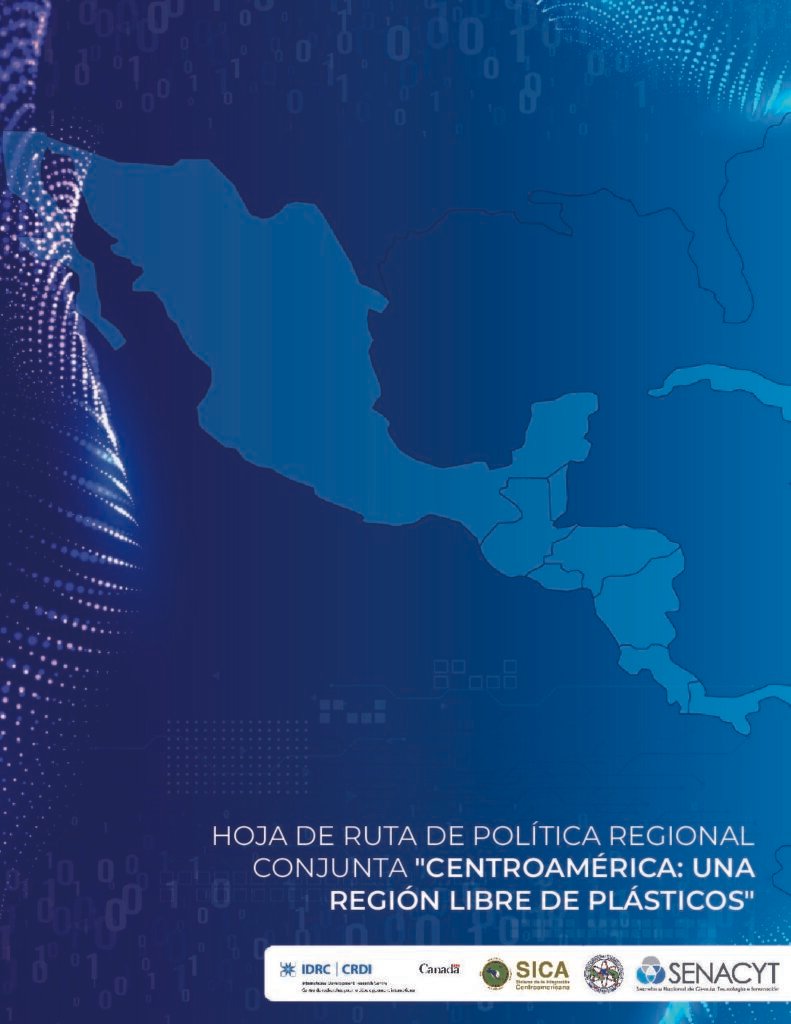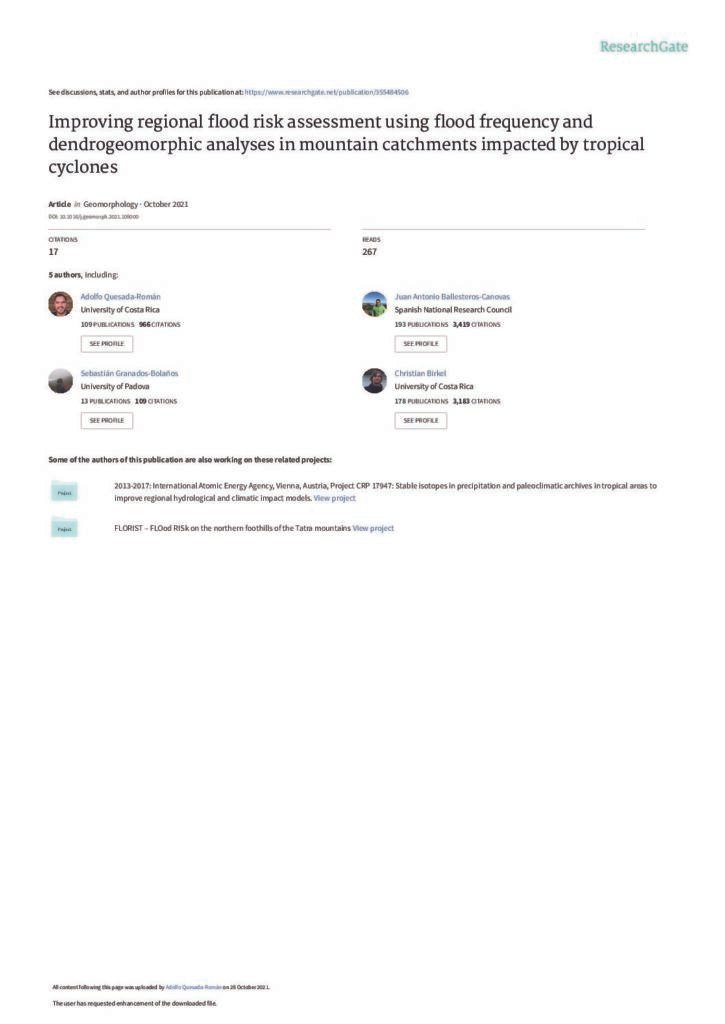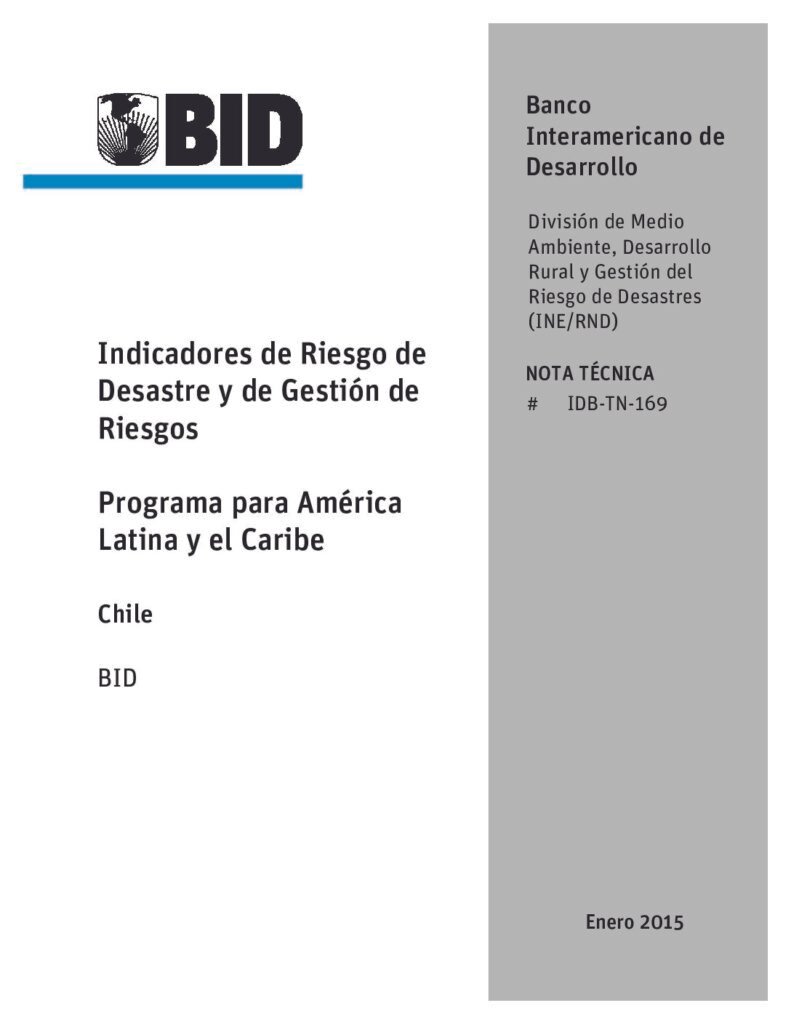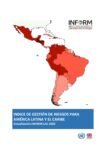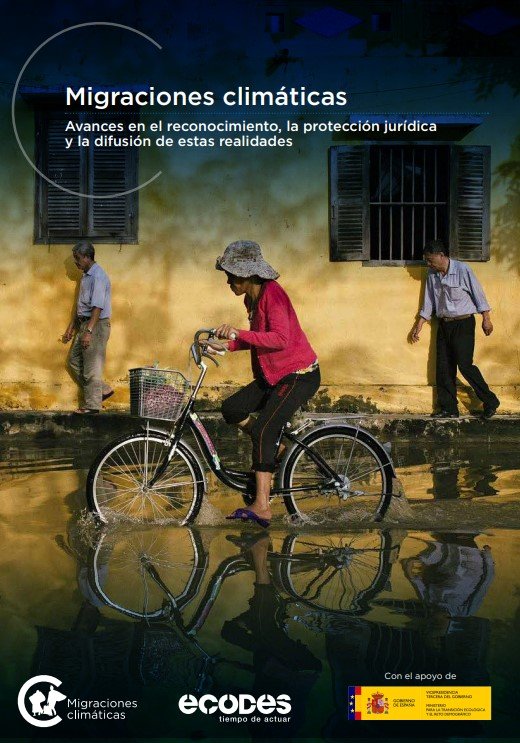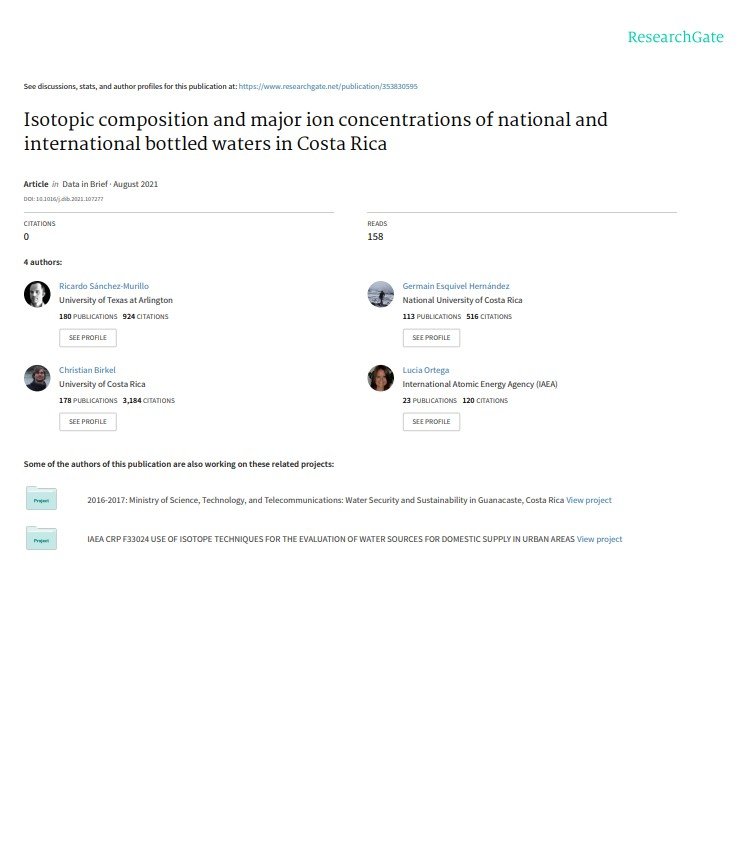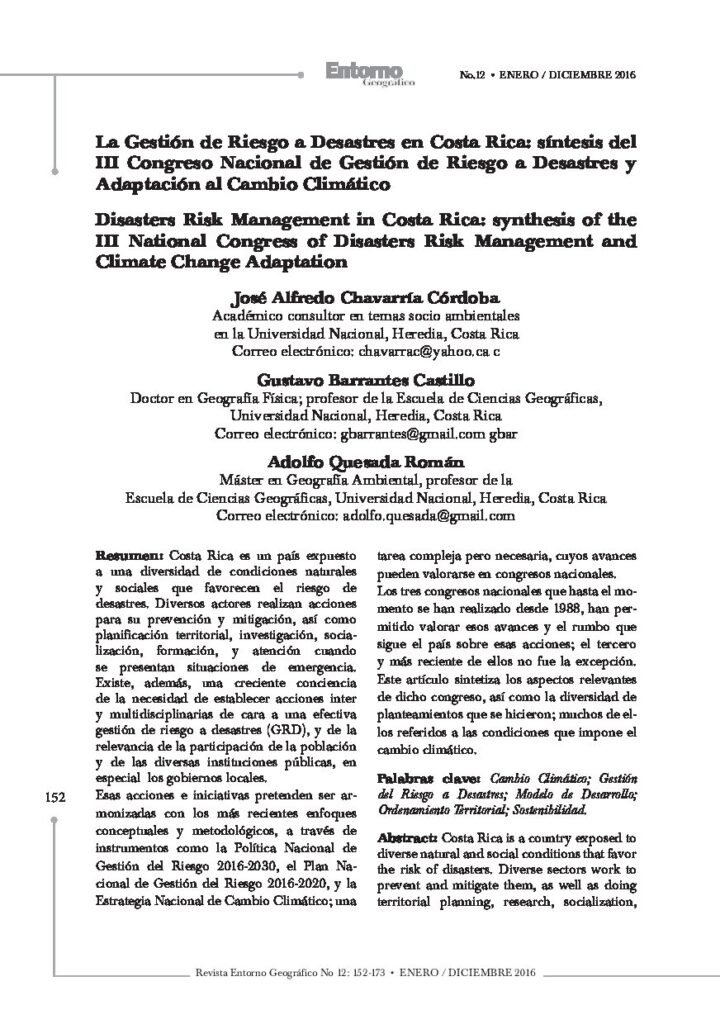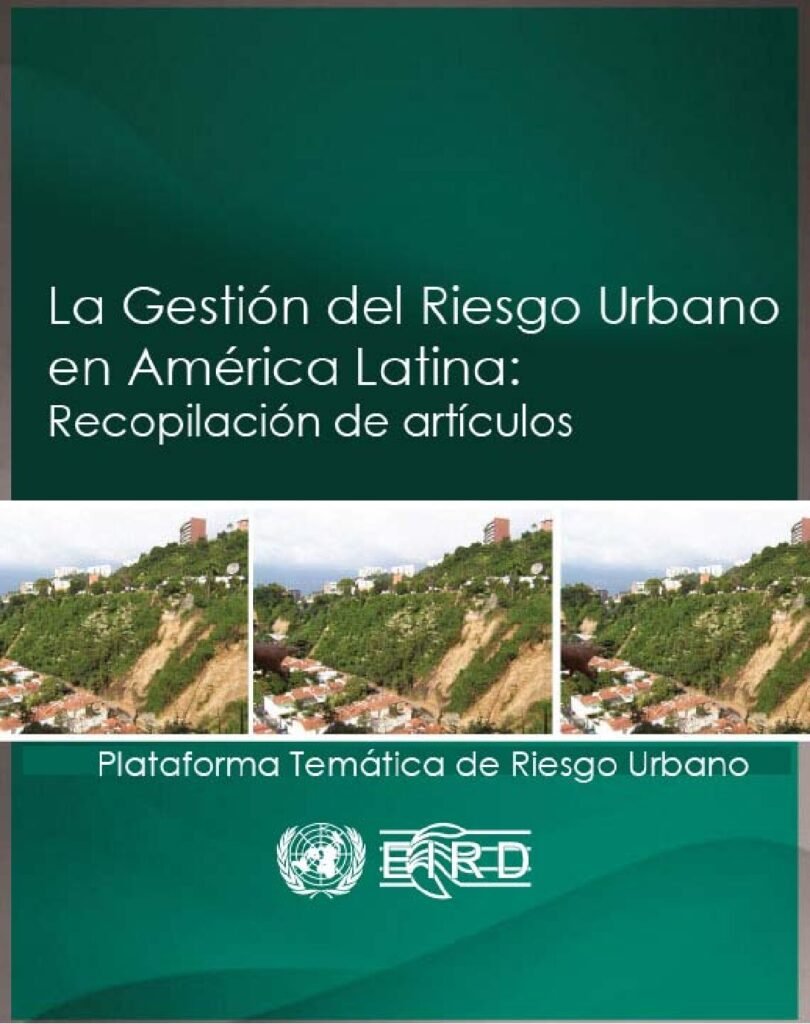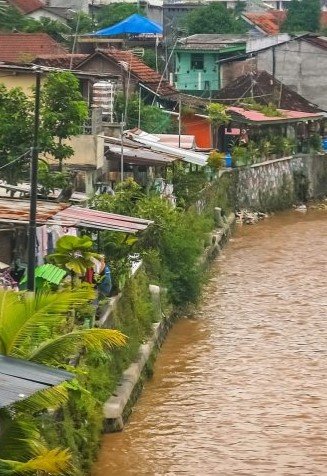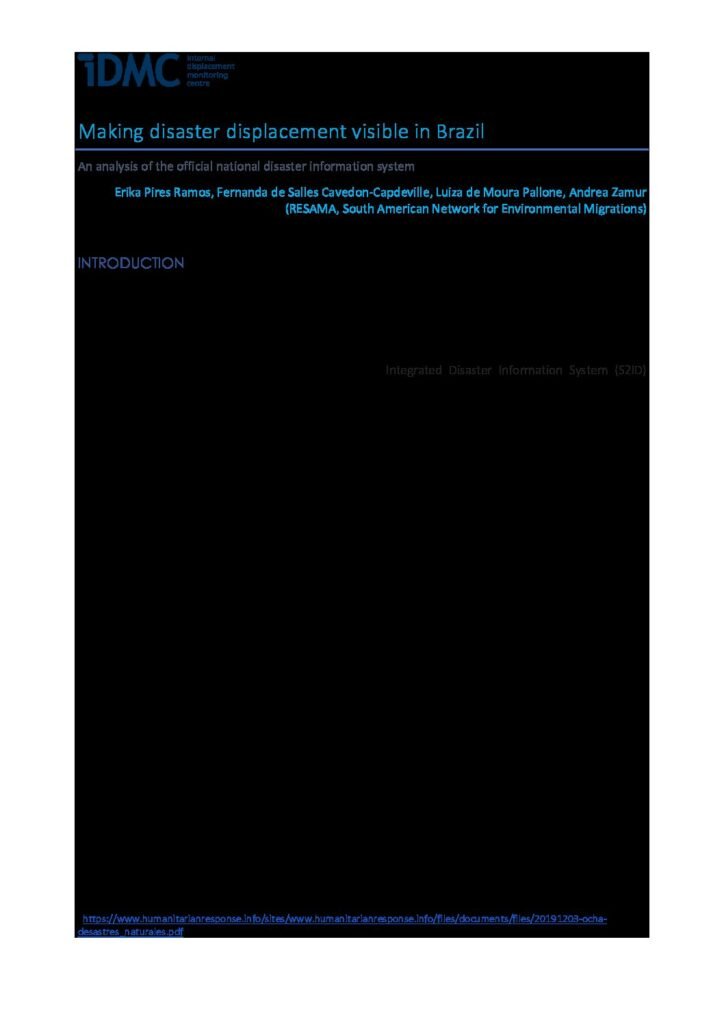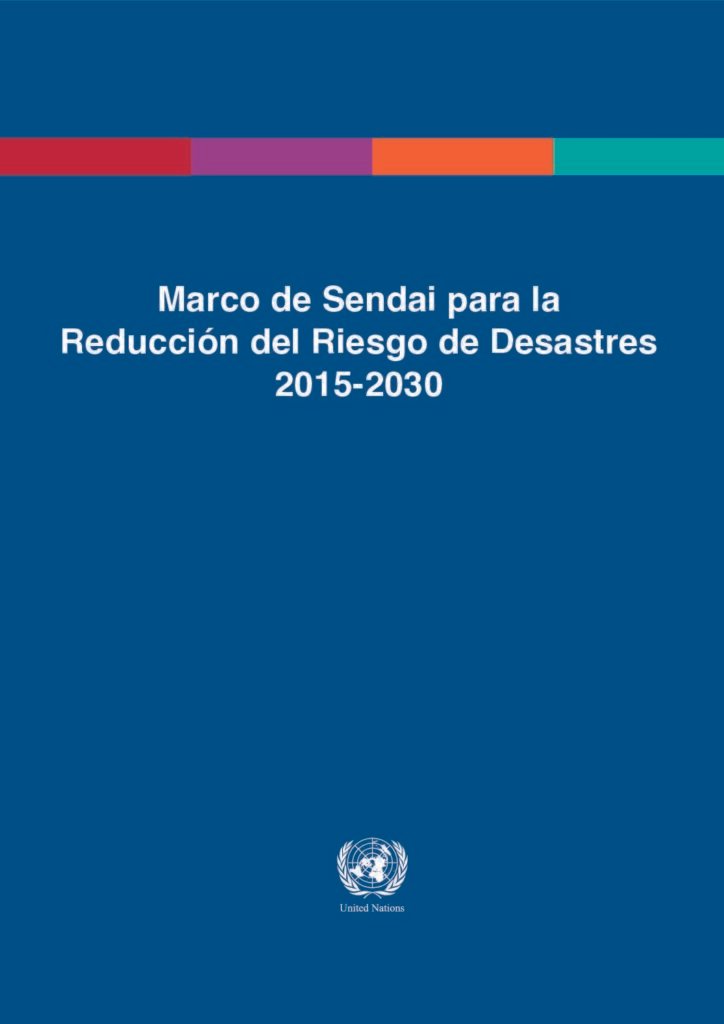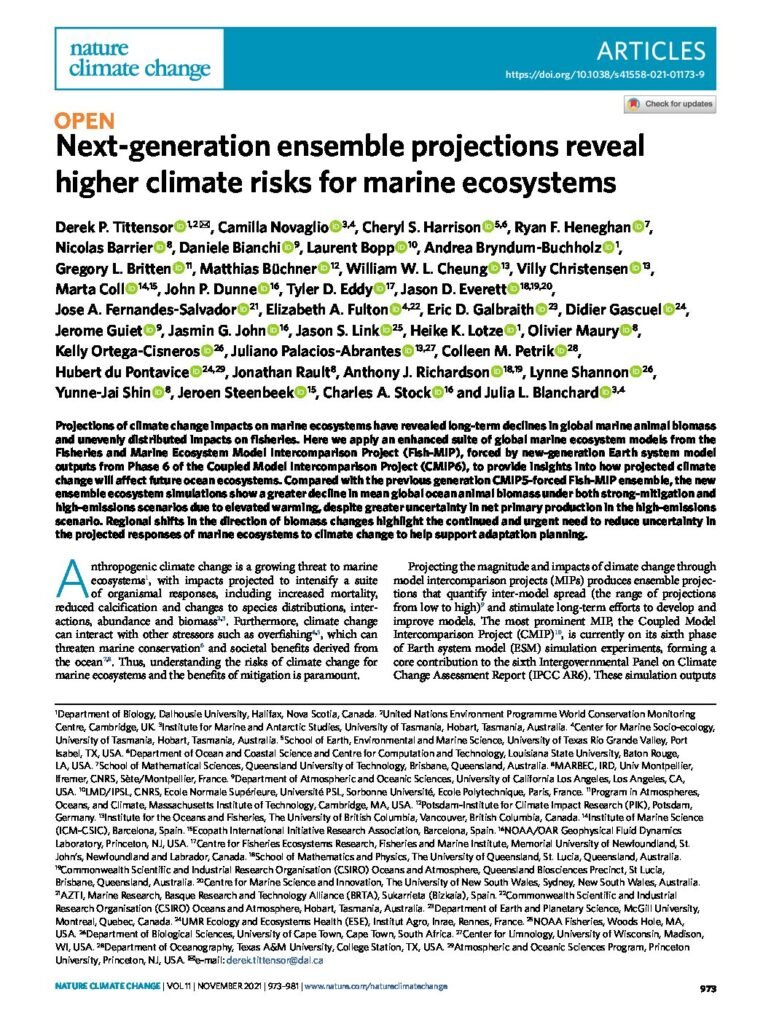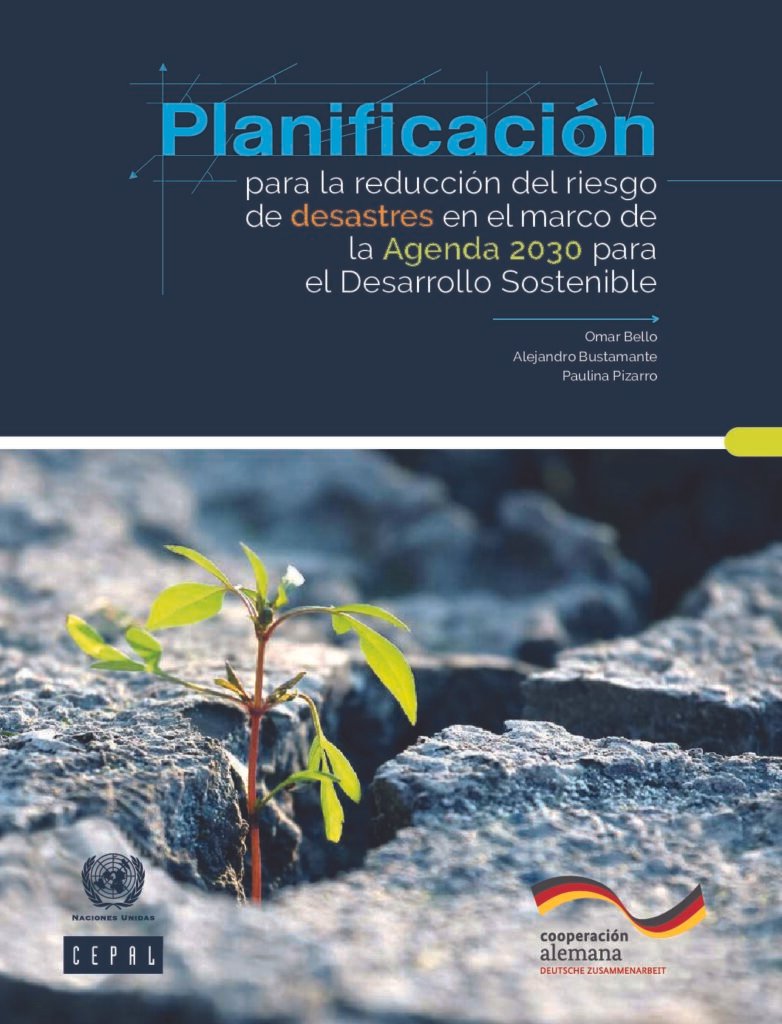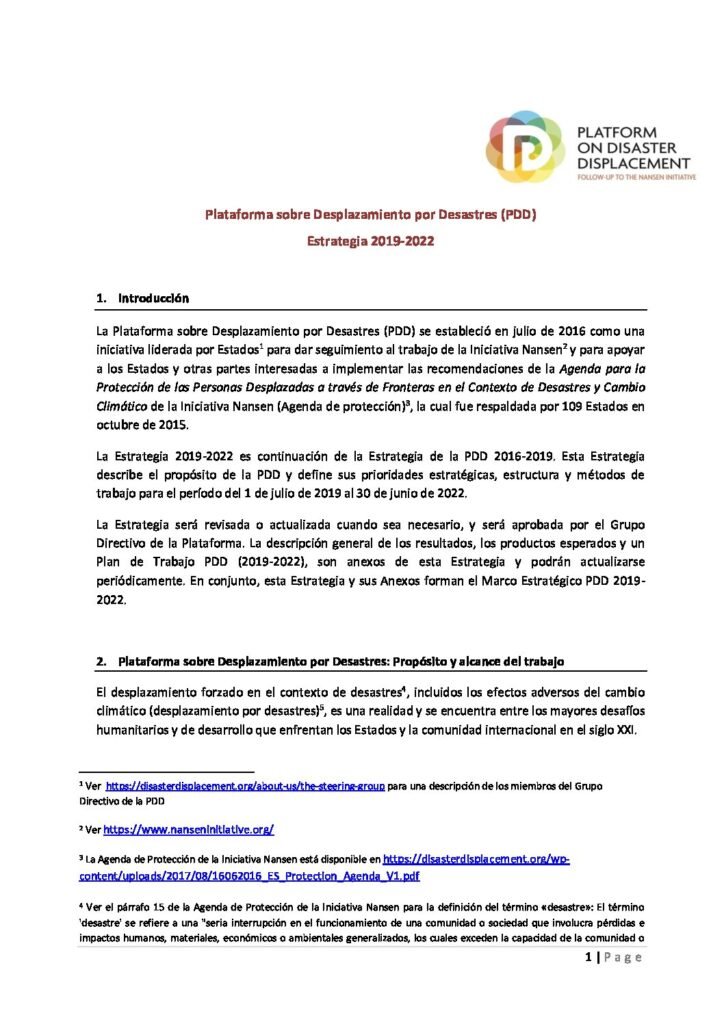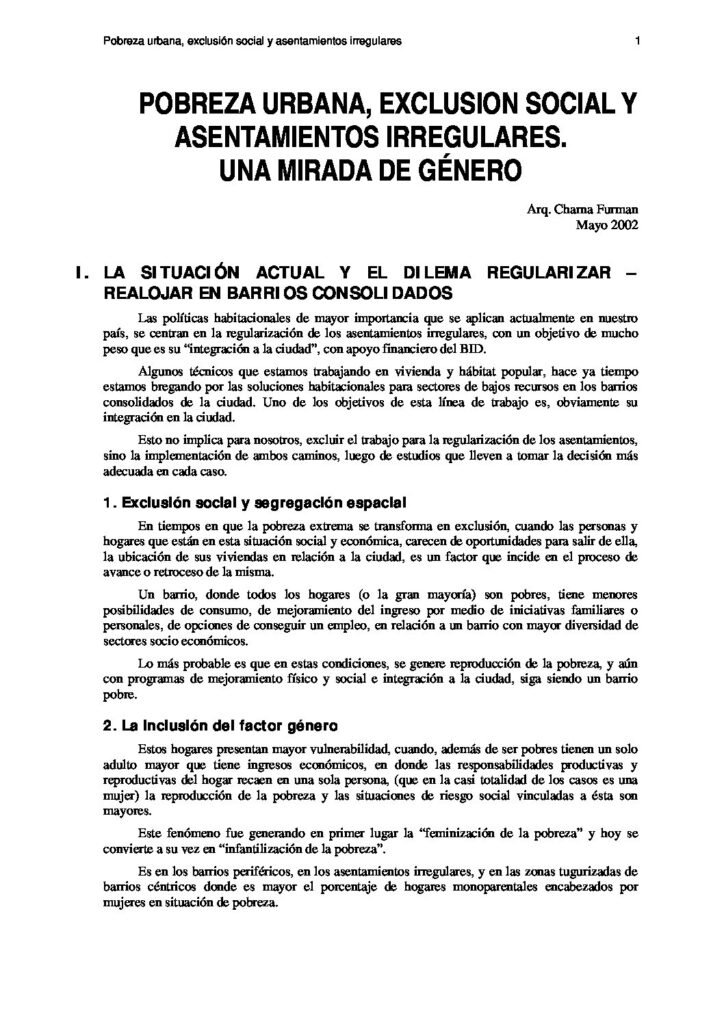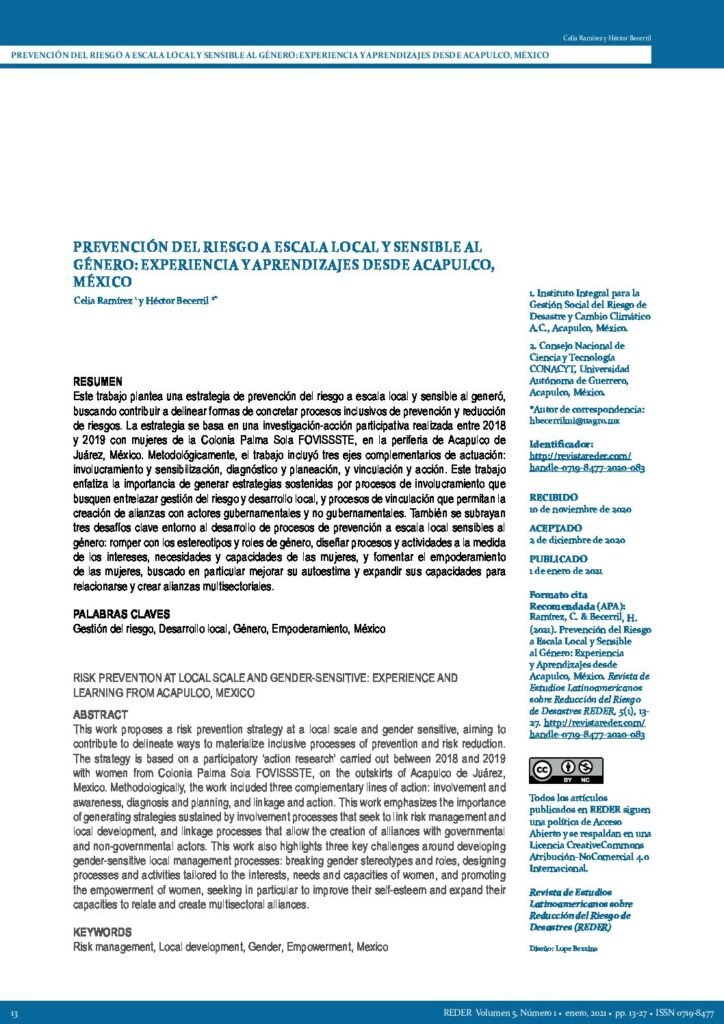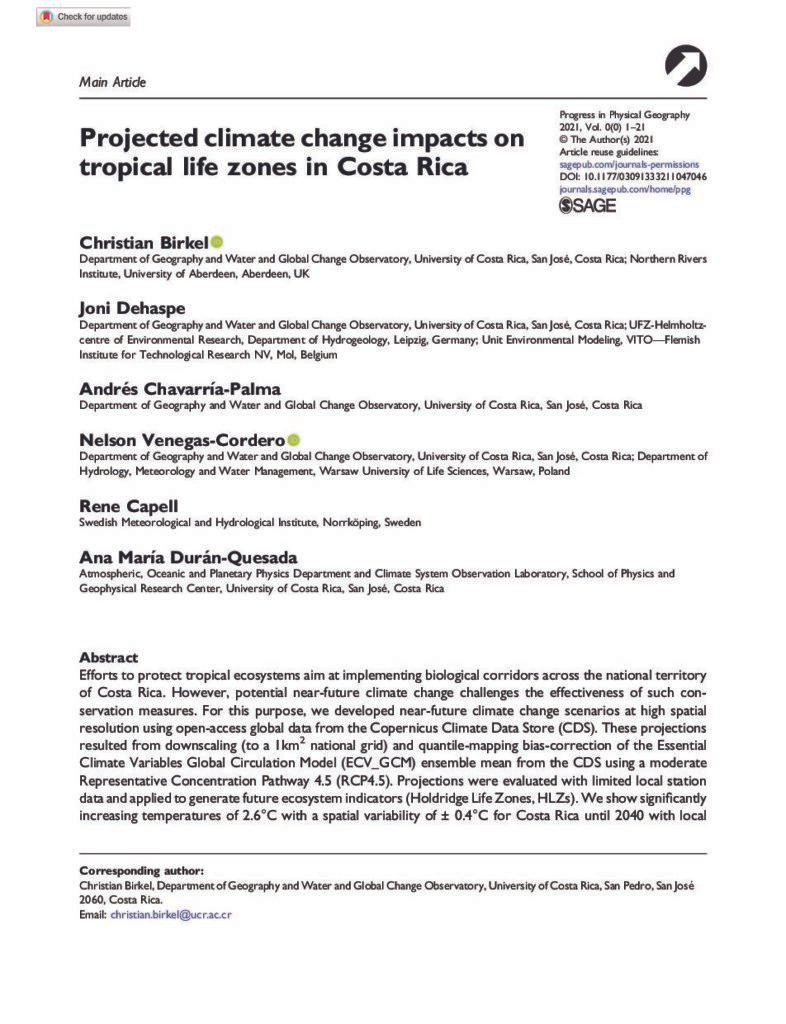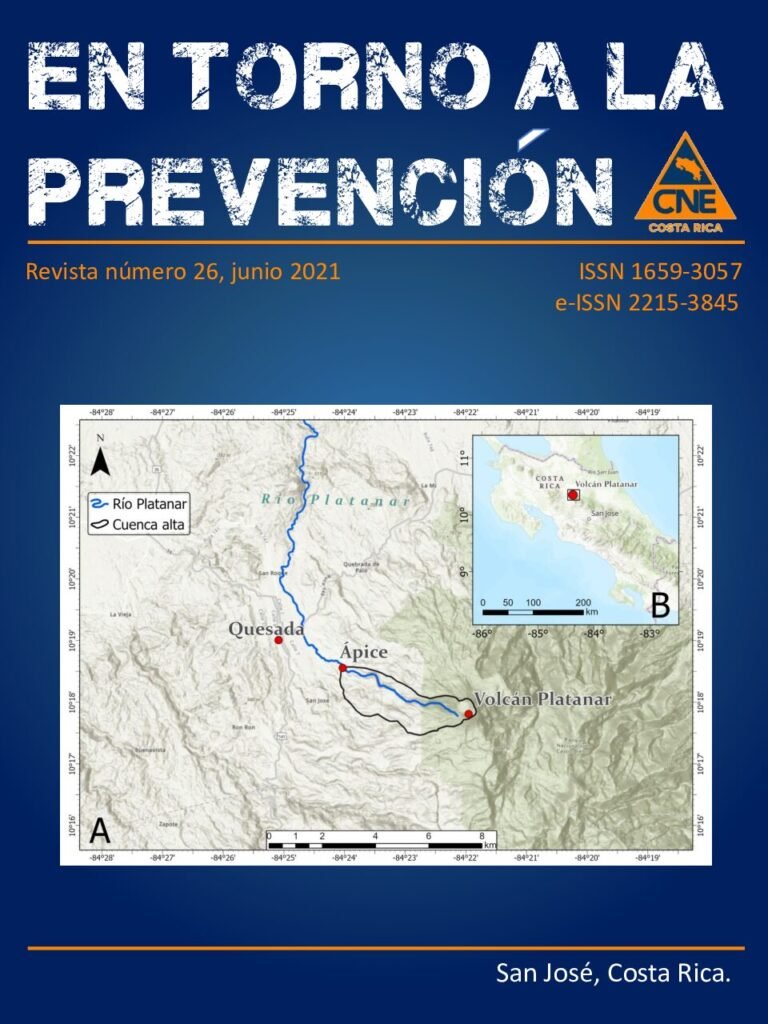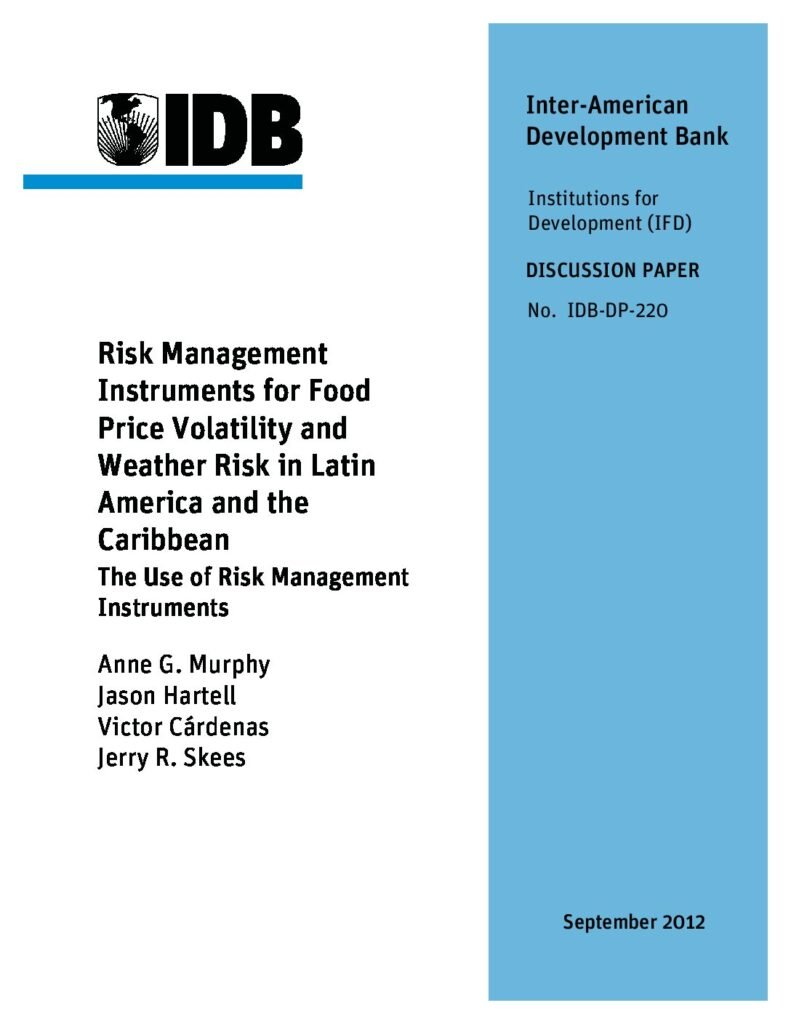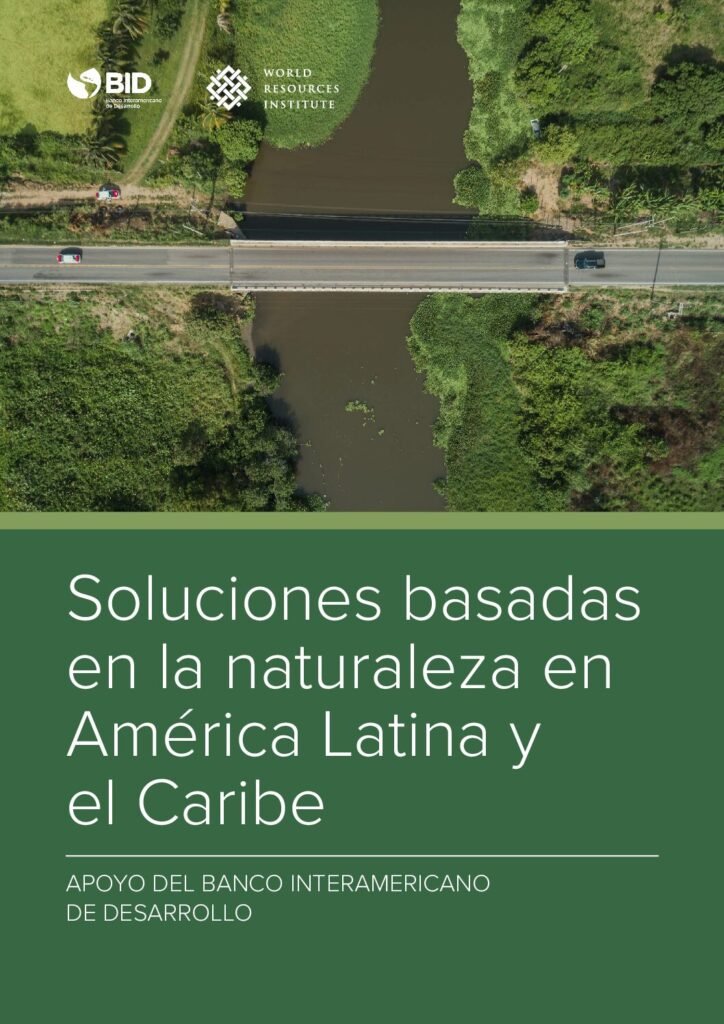documents and publications
| Image | Title | Author | Year | Summary | Categories | Link | doc_categories_hfilter |
|---|---|---|---|---|---|---|---|
| A climate-change risk analysis for world ecosystems | Marko Scholze et al | 2006 | We quantify the risks of climate-induced changes in key ecosystem processes during the 21st century by forcing a dynamic global vegetation model with multiple scenarios from 16 climate models and mapping the proportions of model runs showing forest nonforest shifts or exceedance of natural variability in wildfire frequency and freshwater supply. | Climate change understanding, Risk awareness, Environmental protection/management | comprension-del-cambio-climatico conocimiento-del-riesgo proteccion-gestion-ambiental | ||
| Advances in tsunami preparedness at the beginning of the Ocean Decade: the Costa Rica case, Ocean and Coastal Research | Chacón-Barrantes, S. et al. | 2021 | Following the 2004 Indian Ocean and the 2011 Tohoku earthquakes and tsunamis, there has been steady progress in tsunami science and preparedness worldwide. Currently, there are four Tsunami Warning and Mitigation Systems as Intergovernmental Coordination Groups (ICGs) coordinated by IOC/UNESCO. They include tsunami monitoring, warning, and response. | Risk awareness | conocimiento-del-riesgo | ||
| Women’s Agenda for the City in Latin America | Women and Habitat Network, 2019 | 2019 | Cities are not neutral spaces that guarantee equality for all; on the contrary, they reflect and reproduce inequalities: gender, class, ethnicity, age, nationality, sexual orientation, and their intersectionality. | Education, Public investment, Cultural heritage, Vivienda y Ordenamiento Territorial | educacion inversion-publica patrimonio-cultural vivienda-y-ordenamiento-territorial | ||
| Hazards, risks and disasters | Milanés Batista, Celene | 2017 | This text is proposed as a conceptual tool for disaster risk management. It seeks to advance the understanding of risk and its intervention through a process-based approach. The document is organized into three chapters: the first deals with the theoretical and conceptual aspects of risk management for disaster reduction, identifying the fundamental elements of hazards, vulnerability and risk, describing and accompanying with examples the particularities of each of them. | Risk awareness, Education, Capacity management, Citizen participation | conocimiento-del-riesgo educacion gestion-de-capacidades participacion-ciudadana | ||
| Gender analysis in assessing the socioeconomic effects of natural disasters | CEPAL | 2004 | This paper analyzes the socioeconomic effects of Hurricane Mitch from a gender perspective and proposes new indicators of analysis for crisis situations, which could better reflect the unequal situation of women in relation to men. | Risk awareness, Education, Gender, Capacity management | conocimiento-del-riesgo educacion genero gestion-de-capacidades | ||
| Analysis of Disaster Risk Management Systems, FAO | José ElPensador | 2009 | The Disaster Risk Management (DRM) Systems Analysis Guide provides a set of tools and methodologies to assess the existing structures and capacities of institutions in charge of Disaster Risk Management (DRM) at national, district and local levels, in order to improve their effectiveness and integrate DRM issues into development planning, with special emphasis on disaster-prone areas, vulnerable sectors and population groups. Through the strategic use of the Guide, it is expected to improve the understanding of the strengths, opportunities, weaknesses and threats facing existing DRM institutional structures and their implications for ongoing institutional change processes. | Public communication of risk management, Education, Capacity management | comunicacion-publica-de-la-gestion-de-riesgo educacion gestion-de-capacidades | ||
| AR6 Climate Change 2021: The Physical Science Basis | Reporte ONU | 2021 | The Working Group I contribution to the Sixth Assessment Report addresses the most up-to-date physical understanding of the climate system and climate change, bringing together the latest advances in climate science. | Climate change understanding, Risk awareness, Education, Food security, Water security | comprension-del-cambio-climatico conocimiento-del-riesgo educacion seguridad-alimentaria seguridad-hidrica | ||
| Helping people prepare for natural disasters | DIPECHO | 2003 | A global risk management policy would increase the sustainability of development aid | Public communication of risk management, Education, Capacity management | comunicacion-publica-de-la-gestion-de-riesgo educacion gestion-de-capacidades | ||
| Climate change and disasters | Gustavo Barrantes Castillo | 2013 | This essay aims to confront some beliefs rooted in public opinion about the relationship between climate change and disasters related to hydrometeorological events. Through a review of specialized literature, it is shown that the issue of disasters is more linked to a problem of increased vulnerability than to an increase in natural hazards. Despite the fact that climate change could probably increase the magnitude and frequency of natural hazards in the future, adaptation to climate change should begin by solving current vulnerability problems and by focusing on land use planning as a long-term adaptation process. | Climate change understanding, Risk awareness, Public investment, Environmental protection/management, Vivienda y Ordenamiento Territorial | comprension-del-cambio-climatico conocimiento-del-riesgo inversion-publica proteccion-gestion-ambiental vivienda-y-ordenamiento-territorial | ||
| Climate and Water Conflicts Coevolution from Tropical Development and Hydro-Climatic Perspectives: A Case Study of Costa Rica | Esquivel Hernández et al. | Apri 2018 | Costa Rica is a nation with a vast wealth of water resources; however, recently the country has faced water conflicts due to social, economic, legal, and political impediments in response to limited water availability during El Niño events and inefficient use of its water resources. This study presents a spatial distribution and temporal analysis of water conflicts in Costa Rica from 2005 to 2015. In total, 719 water conflicts were analyzed of which 54% were among private individuals and government. The largest urban areas and the Grande de Tárcoles basin were identified as the main ‘hot spot’ for the conflicts. Water conflicts were mainly caused by spills of wastewater, water pollution, water shortage, infrastructure damage, and flooding, and can be predicted using a multiple linear model including the population size and the number of hydro-meteorological events (R2=0.77). | Climate change understanding, Environmental protection/management, Water security | comprension-del-cambio-climatico proteccion-gestion-ambiental seguridad-hidrica | ||
| Climate tipping points — too risky to bet against | Timothy M. Lenton et al. | 2020 | The growing threat of abrupt and irreversible climate changes must compel political and economic action on emissions. | Climate change understanding, Risk awareness, Environmental protection/management | comprension-del-cambio-climatico conocimiento-del-riesgo proteccion-gestion-ambiental | ||
| Commercial afforestation can deliver effective climate change mitigation under multiple decarbonisation pathways | Eilidh J. Forster et al. | 2021 | Afforestation is an important greenhouse gas (GHG) mitigation strategy but the efficacy of commercial forestry is disputed. Here, we calculate the potential GHG mitigation of a UK national planting strategy of 30,000 ha yr−1 from 2020 to 2050, using dynamic life cycle assessment. What-if scenarios vary: conifer-broadleaf composition, harvesting, product breakouts, and decarbonisation of substituted energy and materials, to estimate 100-year GHG mitigation. | Climate change understanding, Environmental protection/management | comprension-del-cambio-climatico proteccion-gestion-ambiental | ||
| Compound climate risks threaten aquatic food system benefits | Michelle Tigchelaar et al. | 2021 | Aquatic foods from marine and freshwater systems are critical to the nutrition, health, livelihoods, economies and cultures of billions of people worldwide, but climate-related hazards may compromise their ability to provide these benefits. Here, we esti- mate national-level aquatic food system climate risk using an integrative food systems approach that connects climate hazards impacting marine and freshwater capture fisheries and aquaculture to their contributions to sustainable food system outcomes. We show that without mitigation, climate hazards pose high risks to nutritional, social, economic and environmental outcomes worldwide—especially for wild-capture fisheries in Africa, South and Southeast Asia, and Small Island Developing States. For countries projected to experience compound climate risks, reducing societal vulnerabilities can lower climate risk by margins similar to meeting Paris Agreement mitigation targets. System-level interventions addressing dimensions such as governance, gender equity and poverty are needed to enhance aquatic and terrestrial food system resilience and provide investments with large co-benefits towards meeting the Sustainable Development Goals. | Climate change understanding, Risk awareness, Environmental protection/management, Food security, Water security | comprension-del-cambio-climatico conocimiento-del-riesgo proteccion-gestion-ambiental seguridad-alimentaria seguridad-hidrica | ||
| Deforestation-induced climate change reduces carbon storage in remaining tropical forests | Yue Li et al. | 2022 | Biophysical effects from deforestation have the potential to amplify carbon losses but are often neglected in carbon accounting systems. Here we use both Earth system model simulations and satellite–derived estimates of aboveground biomass to assess losses of vegetation carbon caused by the influence of tropical deforestation on regional climate across different continents. | Climate change understanding, Environmental protection/management | comprension-del-cambio-climatico proteccion-gestion-ambiental | ||
| Dendrogeomorphic reconstruction of floods in a dynamic tropical river | Adolfo Quesada et al. | April 2019 | Tropical regions are frequently affected by intense floods causing substantial human and economic losses. A proper management of floods and the prevention of disasters is, however, often hampered by a generalized pau- city of systematic discharge measurements, which in turn renders any assessment of the frequency and magni- tude of extreme floods challenging or impossible. Here, we analyze the suitability of trees impacted by floods and their growth-ring records to provide insights into past flood activity and to allow estimation of their magnitude. We base this exploratory study on the extreme floods triggered by the passage of tropical storm Nate on October 5, 2017 and investigate whether dendrogeomorphic approaches can be employed to date and quantify floods in the catchment of tropical Río General (Costa Rica). | Climate change understanding, Risk awareness, Environmental protection/management | comprension-del-cambio-climatico conocimiento-del-riesgo proteccion-gestion-ambiental | ||
| Rights, legislation and practices. Access to Housing and the City | Liliana Rainero | 2005 | This document presents some reflections on a human right recognized in the Universal Declaration of Human Rights (1948) and ratified by various international instruments, particularly the International Covenant on Economic, Social and Cultural Rights, which refers to the right to "adequate housing" as part of the right to an "adequate life". This implies a non-restrictive concept of housing, (i.e. not limited to "a roof over one's head") but as habitat in an integral sense, i.e. the right to an environment that guarantees services, accessibility to the different activities that make life possible, environmental quality and safety, as a human right of all people. We will refer to this right and its significance for women. | Gender, Public investment, Civil society participation, Vivienda y Ordenamiento Territorial | genero inversion-publica participacion-de-la-sociedad-civil vivienda-y-ordenamiento-territorial | ||
| Disasters and Development: Towards an Understanding of the Forms of Social Construction of a Disaster: The Case of Hurricane Mitch in Central America. | Allan Lavell | 2000 | During the present decade, the debate on the relationship between disasters, development, environment and sustainability, and its implications for risk and disaster management, has matured at an accelerated pace. The topic has become a point of reference and reflection, almost compulsory. This is due, among other factors, to the following circumstances: the emphasis placed on the subject of risk reduction and development during the International Decade for Natural Disaster Reduction, the unprecedented losses generated by disasters associated with Hurricane Andrew in Florida, the Mississippi River floods and the Northridge and Kobe earthquakes, the generally accepted fact, that the number and impact of disasters is rapidly increasing worldwide, the idea that factors such as global climate change, the introduction of new hazardous technologies and the marked increase in levels of social vulnerability could create conditions conducive to a dramatic increase in the number of disasters in the future. | Risk awareness, Education, Vivienda y Ordenamiento Territorial | conocimiento-del-riesgo educacion vivienda-y-ordenamiento-territorial | ||
| Diagnosis of the current situation of national and regional information and communication systems, and proposal of an information and communication platform for integrated disaster risk management. | Jorge Calvo-Drago | 2010 | Chapter 1 presents an introduction to the risk management information and communication systems diagnosis and the proposed information and communication platform. It points out some of the limitations encountered in the research and how they were overcome. Chapter 2 presents the background of the Taiwan project through a brief chronology that begins with the "Regional Information System for Natural Disaster Prevention" approved in 2001 by the Board of Directors of CEPREDENAC and goes up to the present objectives and phases of the project. | Public communication of risk management, Education, Capacity management, Public investment | comunicacion-publica-de-la-gestion-de-riesgo educacion gestion-de-capacidades inversion-publica | ||
| Disasters and loss of life: New Evidence on the effect of disaster risk managemente governance in Latin America and the Carribean | Roberto Guerrero Compeán y Sergio Lacambra Ayuso | 2020 | This study provides new empirical evidence on the effect of improving the conditions in disaster risk man- agement (DRM) governance in terms of human losses resulting from disaster events. To measure govern- ance in disaster risk management, we use the Index of Governance and Public Policy in Disaster Risk Management (IGOPP ), developed by the Inter -American Development Bank, which characterizes the de- velopment of regulatory, institutional and budgetary processes for disaster risk management at the national level . This analysis use regression models of count data for 26 countries in Latin America and the Caribbean for the 1980- 2017 period. | Risk awareness, Education, Capacity management | conocimiento-del-riesgo educacion gestion-de-capacidades | ||
| Design of disaster risk assessment tools for the conservation of Immovable Cultural Heritage: Application in two case studies in the northern Chilean Andes. | Daniela Díaz | 2016 | Risk, defined as the combination of the probability of a hazard occurring and its negative consequences on people or property, is a recent concept in the field of immovable cultural heritage conservation. Each year, in geographic areas with a high risk of natural catastrophes such as the Ring of Fire or Circum Pacific, the development of comprehensive risk management plans could reduce damage to cultural property by establishing criteria for prioritizing public or private investment, and by guiding preventive conservation projects and mitigation works. | Public communication of risk management, Education, Energy, Capacity management, Water security, Vivienda y Ordenamiento Territorial | comunicacion-publica-de-la-gestion-de-riesgo educacion energia gestion-de-capacidades seguridad-hidrica vivienda-y-ordenamiento-territorial | ||
| Economic impacts of tipping points in the climate system | Simon Dietz et al. | 2021 | Climate scientists have long emphasized the importance of cli- mate tipping points like thawing permafrost, ice sheet disintegra- tion, and changes in atmospheric circulation. Yet, save for a few fragmented studies, climate economics has either ignored them or represented them in highly stylized ways. We provide unified esti- mates of the economic impacts of all eight climate tipping points covered in the economic literature so far using a meta-analytic integrated assessment model (IAM) with a modular structure. The model includes national-level climate damages from rising tem- peratures and sea levels for 180 countries, calibrated on detailed econometric evidence and simulation modeling. | Climate change understanding, Risk awareness, Financial protection | comprension-del-cambio-climatico conocimiento-del-riesgo proteccion-financiera | ||
| Edición Oct 2017 de la Revista Forced Migration Review – Latin America and the Caribbean building on a tradition of protection | Diogo Andreola Serraglio et al. | The region of Latin America and the Caribbean has long demonstrated hospitality towards those fleeing conflict and persecution within the region and from further afield. Faced with newer causes of displacement, such as the violence of organised criminal gangs and the adverse effects of climate change, Latin American and Caribbean countries are continuing to expand and adapt their protection laws and mechanisms in order to address these and other situations of displacement and to meet the differing needs of affected populations. This issue contains 31 articles on Latin America and the Caribbean, plus five ‘general’ articles on other topics. | Climate change understanding, Risk awareness, Capacity management, Environmental protection/management | comprension-del-cambio-climatico conocimiento-del-riesgo gestion-de-capacidades proteccion-gestion-ambiental | |||
| Edición Oct 2017 de la Revista Forced Migration Review – Latin Americaand the Caribbean building on a tradition of protection | Diogo Andreola Serraglio et al. | 2017 | The region of Latin America and the Caribbean has long demonstrated hospitality towards those fleeing conflict and persecution within the region and from further afield. Faced with newer causes of displacement, such as the violence of organised criminal gangs and the adverse effects of climate change, Latin American and Caribbean countries are continuing to expand and adapt their protection laws and mechanisms in order to address these and other situations of displacement and to meet the differing needs of affected populations. This issue contains 31 articles on Latin America and the Caribbean, plus five ‘general’ articles on other topics. | Climate change understanding, Risk awareness, Capacity management, Environmental protection/management | comprension-del-cambio-climatico conocimiento-del-riesgo gestion-de-capacidades proteccion-gestion-ambiental | ||
| Climate change and disaster risk reduction | Miguel Pleitez | 2008 | Climate change and disaster risk reduction (CC/DRR for the purposes of this paper) are closely related. The increase in extreme weather events in the future is likely to increase the number and magnitude of disasters, but at the same time, existing methods and tools for DRR offer powerful capacities for adaptation to climate change | Climate change understanding, Public communication of risk management, Risk awareness, Education, Environmental protection/management | comprension-del-cambio-climatico comunicacion-publica-de-la-gestion-de-riesgo conocimiento-del-riesgo educacion proteccion-gestion-ambiental | ||
| COVID-19: Relationship to disaster risk, its concept and management | Allan Lavell y Chris Lavell | 2020 | This paper evolved in early April 2020 in response to the need to discuss commonalities between COVID-19 and more well-established and well-known disaster contexts, and the causal processes, actions and policies used to address them. The writing of this paper was halted for four weeks because the author collaborated with other colleagues, to write a paper on COVID-19 and risk management from the angle of political economy and government action. | Public communication of risk management, Capacity management, Public investment | comunicacion-publica-de-la-gestion-de-riesgo gestion-de-capacidades inversion-publica | ||
| The impact of integrated risk management in today's context | José Oswaldo Franco Reina | 2022 | This article seeks a reflection on the need for a comprehensive approach to risk management, projecting into the future, whose main challenge will be the reduction of disaster risk with a change of approach, going from a vision linked to the unpredictability and inevitability of its occurrence, to consider it as a problem linked to the processes of productive sustainable development of organizations, communities, regions and countries, in society, which have a positive impact on the community, hand in hand with the use, planning and management of the territory they occupy. This renewed integral approach implies a fundamental component, the reduction of existing vulnerability, as well as the promotion and encouragement of schemes for the transformation of society. | Risk awareness, Education | conocimiento-del-riesgo educacion | ||
| Land use planning for disaster risk management in Colombia | Daniel Calderón Ramírez | 2016 | In Colombia, the Organic Law of Territorial Planning (LOOT) is one of the tools that allowed the restructuring of the National System of Risk Management, generating that the territorial entities could be organized in a joint management at the central level, under the principles of decentralization, coordination, complementarity and concurrence; this with the objective of promoting coordinated strategic actions towards risk awareness, risk reduction and emergency management. In this way, the LOOT has allowed improving the competencies of the territorial entities for disaster risk management, through the transfer of greater autonomy from the national level to the departments and municipalities, as well as the strengthening of municipal associations such as the case of the Metropolitan Area of the Aburrá Valley and its intermunicipal risk management plan -Red Riesgos. | Education, Capacity management, Public investment, Vivienda y Ordenamiento Territorial | educacion gestion-de-capacidades inversion-publica vivienda-y-ordenamiento-territorial | ||
| Interview with Liliana Rainero: It is necessary to incorporate the voice of women in order to think of responses that guarantee safer cities | Liliana Rainero | 2004 | Interview with Liliana Rainero (CISCSA-Women and Habitat Network Coordination LAC) by Misión Bogotá, in the framework of the II International Conference "Safe Cities for Women and Girls", held in November 2004, in Bogotá (Colombia). | Education, Gender, Public investment, Vivienda y Ordenamiento Territorial | educacion genero inversion-publica vivienda-y-ordenamiento-territorial | ||
| Estimating the global risk of anthropogenic climate change | Alexandre K. Magnan et al | 2021 | The three recent Special Reports of the IPCC provide an opportunity to understand overarching climate risk, as they cover a wide diversity of risks to natural and human systems. Here we develop a scoring system to translate qualitative IPCC risk assessments into risk scores that, when aggregated, describe global risk from climate change. By the end of this century, global climate risk will increase substantially with greenhouse gas emissions compared to today (composite risk score increase of two- and fourfold under RCP2.6 and RCP8.5, respectively). Comparison of risk levels under +1.5 °C and +2 °C suggests that every additional 0.5 °C of global warming will contribute to higher risk globally (by about a third). Societal adaptation has the potential to decrease global climate risk substantially (by about half) under all RCPs, but cannot fully prevent residual risks from increasing (by one-third under RCP2.6 and doubling under RCP8.5, compared to today | Climate change understanding, Risk awareness, Environmental protection/management | comprension-del-cambio-climatico conocimiento-del-riesgo proteccion-gestion-ambiental | ||
| Evaluación del potencial de tsunamis locales con base en análisis sismo-tectónico en el Caribe de Costa Rica | Zamora, N. et al. | 2021 | In Costa Rica, despite their relative low frequency, tsunamis could pose risk to coastal communities. The integration of geophysical and geological information allows the interpretation of possible rupture areas for which tsunami propagation and inundation is evaluated through numerical modeling along the Caribbean of Costa Rica and areas adjacent to the tsunamigenic ear-thquake that occurred in 1991 (Mw 7,7). The results show that the tsunami threat in the Caribbean of Costa Rica arises particularly from earthquakes generated in the North Panama Deformation Belt. In addition, it is shown that medium-magnitude earthquakes (Mw ~ 7) in high-angle faults can cause local tsunamis. This work can be used as a basis for the generation of evacuation maps and awareness of the tsunami threat in the area | Risk awareness | conocimiento-del-riesgo | ||
| Statistical sources for the study of disaster risk management in Central America. The DesInventar database and its contributions to historical research. | Yolanda Zúñiga Arias et al. | 2019 | The main objective of this article is to describe the potential of the DesInventar database as a historical source. Particularly, the contributions of this "statistical repository" for research on disaster risk management with a Central American perspective are mentioned. | Public communication of risk management, Capacity management, Public investment | comunicacion-publica-de-la-gestion-de-riesgo gestion-de-capacidades inversion-publica | ||
| Disaster risk management in Latin American cities | Max Watanabé | 2015 | In Latin America, the most urbanized region in the world, serious problems of poverty and inequality persist; 111 million people live in informal settlements that are highly vulnerable to disasters. 80% of the impact of disasters is felt in cities and affects mainly the poorest populations. This guide describes the complex interaction between urbanization processes and natural hazards that generate and intensify disaster risks in Latin America. | Public communication of risk management, Risk awareness, Education, Capacity management, Vivienda y Ordenamiento Territorial | comunicacion-publica-de-la-gestion-de-riesgo conocimiento-del-riesgo educacion gestion-de-capacidades vivienda-y-ordenamiento-territorial | ||
| Disaster Risk Management for World Heritage, UNESCO | Shirley Condorhuacho | 2014 | Since the adoption of the World Heritage Convention in 1972, the World Heritage List has been constantly evolving and growing and there has been a pressing need to strengthen the delivery of guidelines for the implementation of the Convention in States Parties. The various expert meetings and the findings of the Periodic Reports identify the need to further focus training and capacity-building activities on the specific areas where States Parties and World Heritage site managers need the most support. The development of the World Heritage Reference Manuals series is a response to this need. | Public communication of risk management, Education, Capacity management | comunicacion-publica-de-la-gestion-de-riesgo educacion gestion-de-capacidades | ||
| Disaster risk management and cultural heritage in Central America and the Dominican Republic | Bárbara Mínguez García Raquel Lejtreger | 2020 | This report has been prepared by Raquel Lejtreger and Bárbara Mínguez García, Disaster Risk Management (DRM) | Climate change understanding, Risk awareness, Education, Cultural heritage | comprension-del-cambio-climatico conocimiento-del-riesgo educacion patrimonio-cultural | ||
| Financial Risk Management | Omar Darío Cardona | 2009 | This document has been produced for two main purposes: (i) to provide an overview of the current situation regarding disaster risk retention and transfer mechanisms in the Andean Subregion; and (ii) to propose a series of general and specific recommendations for each country to encourage and promote financial protection against risks and disasters. This study required consulting work that included visits to the countries, discussions, an Andean Subregional Workshop held in March 2008 in Lima, with the participation of more than 70 officials from the Subregion, and the subsequent socialization and review of the results after the workshop. | Capacity management, Public investment, Financial protection | gestion-de-capacidades inversion-publica proteccion-financiera | ||
| Local risk management | Allan Lavell | 2003 | Risk management, and local risk management in particular, has strongly emerged over the last four years. This has been particularly noticeable in Central America, but is also widespread in many other Latin American countries. During this time both the concept and practice has evolved, however, the diversity of approaches, interpretations and practices that have been developed, coined by the very notion of risk management, suggest that there is still no clarity and consensus as to its meaning. | Public communication of risk management, Education | comunicacion-publica-de-la-gestion-de-riesgo educacion | ||
| Global adaptation readiness and income mitigate sectoral climate change vulnerabilities | Samuel Asumadu Sarkodie y et al. | 2022 | Climate change has become a global burden, requiring strong institutional quality and will- ingness to mitigate future impacts. Though emissions are transboundary and have the ten- dency of spreading from high emitting countries to low emitting countries, regional exposure, sensitivity, and adaptation readiness determine the extent of climate effects. The existing literature focuses on immediate drivers and damages of emission effects, failing to account for underlying mechanisms occurring via the nexus between emission levels, economic, social, and governance adaptation readiness. Here, this study broadens the scope of previous attempts and simultaneously examines climate change vulnerability across sectors including ecosystem services, food, health, human habitat, infrastructure, and water. | Climate change understanding, Risk awareness, Capacity management, Environmental protection/management, Food security, Water security | comprension-del-cambio-climatico conocimiento-del-riesgo gestion-de-capacidades proteccion-gestion-ambiental seguridad-alimentaria seguridad-hidrica | ||
| Global trends in advancing tsunami science for improved hazard and risk understanding, Contributing Paper to GAR (Global Assessment Report on Disaster Risk Reduction) | Løvholt et al. | 2019 | This paper provides a timely review of progress and ongoing research needs in tsunami hazard and risk science since the most recent major event, the Tohoku tsunami in 2011. The tsunami community has made significant progress in understanding tsunami hazard from seismic sources. However, this is only part of the inputs needed to effectively manage tsunami risk, which should be understood more holistically, including non-seismic sources, vulnerability in different dimensions and the overall societal effects, in addition to its interaction with other hazards and cascading effects. Moreover, higher standards need to be achieved as far as the management of subjective choices and uncertainty quantification, which largely govern the basis for tsunami risk decision making. | Risk awareness, Education | conocimiento-del-riesgo educacion | ||
| Towards political and legal recognition of climate displacement in Mexico | Armelle Gouritin | 2021 | According to the 2018 World Bank Groundswell report, by 2050 and in a worst-case scenario, more than 3 million people will be forced to move in Mexico due to climate change.Despite its magnitude, it is only recently that the Mexican political-legal framework has begun to address the phenomenon. In this contribution to the Climate Migrations blog, we report on the evolutions of the Mexican political-legal framework to address climate displacement and provide some keys for critical analysis of this framework. | Climate change understanding, Risk awareness, Public investment, Environmental protection/management | comprension-del-cambio-climatico conocimiento-del-riesgo inversion-publica proteccion-gestion-ambiental | ||
| Joint regional policy roadmap "Central America: a plastic-free region | SICA | 2022 | The main objective of this project is to define a proposal for the formulation of a joint regional policy roadmap for technological development and mission-oriented innovation. Such a roadmap will enable to face the great challenge of creating a Central American region free of plastics. In the preparation of this Project, the conceptual and methodological framework elaborated by Mietzinki, Mazzucato and Ekins (2019) has been followed, and an important part of their discussions has been taken from. | Capacity management, Private investment, Public investment, Environmental protection/management | gestion-de-capacidades inversion-privada inversion-publica proteccion-gestion-ambiental | ||
| Improving regional flood risk assessment using flood frequency and dendrogeomorphic analyses in mountain catchments impacted by tropical cyclones | Quesada et al. | 2021 | River floods frequently occur when tropical cyclones hit land. Nonetheless, systematic, long-term discharge data remain rather scarce in many tropical countries, which prevents proper analysis of peak discharges occurring during floods. The Térraba catchment is the biggest and most dynamic catchment in Costa Rica. In this study, we developed regional flood-frequency analyses combining tree-ring based estimation and measurement of peak discharge at monitoring stations during tropical cyclones to derive flood quartiles. Flood quartiles were combined with the Topographic Wetness Index (TWI) to determine regional flood hazards along floodplains. | Risk awareness | conocimiento-del-riesgo | ||
| Disaster Risk and Risk Management Indicators, Latin America and the Caribbean Program | BID | 2015 | Disaster risk depends not only on the possibility of the occurrence of intense natural events or phenomena, but also on the conditions of vulnerability that favor or facilitate the occurrence of disasters when such phenomena occur. Vulnerability is closely linked to the social processes that take place in hazard-prone areas and usually has to do with the fragility, susceptibility or lack of resilience of the population to hazards of different types. | Risk awareness, Education | conocimiento-del-riesgo educacion | ||
| Risk Management Index for Latin America and the Caribbean | INFORM | 2020 | INFORM-LAC is a tool for understanding and assessing the risk of disasters and humanitarian crises in the countries of the region. INFORM products can be used to support prioritization and decision making related to crisis and disaster prevention, preparedness and response. In addition, the tool could be used to monitor risk trends over time. This would make it possible to see in the medium and long term the effectiveness of the actions that have been implemented to manage these risks. | Public communication of risk management, Education, Capacity management, Public investment | comunicacion-publica-de-la-gestion-de-riesgo educacion gestion-de-capacidades inversion-publica | ||
| Resama Position Report n.01: Environmental Migration in the Global Compact for Safe, Orderly and Regular Migration: Challenges and Contributions for Latin America and the Caribbean | Erika Pires Ramos et al. | 2018 | Disasters, intensified by the effects of climate change, are recurring in Latin America and the Caribbean, one of the most fragile and vulnerable regions of the planet in the face of these phenomena. According to the Food and Agriculture Organization of the United Nations (FAO), at least 70 extreme weather events occur every year in this part of the world, while 70% of annual emergencies are weather-related. In addition, one third of the total population lives in areas at high risk of disasters. | Climate change understanding, Risk awareness, Capacity management, Public investment, Environmental protection/management | comprension-del-cambio-climatico conocimiento-del-riesgo gestion-de-capacidades inversion-publica proteccion-gestion-ambiental | ||
| Report: Towards a More Resilient Central America: Pillars for Action | Banco Mundial | 2019 | In a context of high socioeconomic and environmental vulnerability, associated with processes of inequality, poverty, inadequate land use, unplanned urbanization and environmental degradation, among others, the occurrence of natural hazards frequently translates into disasters, whose impacts in terms of human and economic losses have a major impact on the sustainability of the region's development processes. | Risk awareness, Education, Gender, Capacity management, Public investment, Financial protection | conocimiento-del-riesgo educacion genero gestion-de-capacidades inversion-publica proteccion-financiera | ||
| Climate Migrations Report: progress in the recognition, legal protection and dissemination of these realities | Beatriz Felipe Pérez | 2021 | This report provides continuity to the activities and publications that the Ecology and Development Foundation (ECODES), accompanied by SdeO Comunicación, has been carrying out since 2015 on the topic of climate migrations. This is the fourth research study framed in the project on climate migrations developed by both entities. | Climate change understanding, Risk awareness, Education, Gender | comprension-del-cambio-climatico conocimiento-del-riesgo educacion genero | ||
| Isotopic composition and major ion concentrations of national and international bottled waters in Costa Rica | Sánchez-Murillo et al. | August 2021 | Global bottled water consumption has largely increased (14.35 billion gallons in 2020) during the last decade since consumers are demanding healthier and safer forms of rehydration. Bottled water sources are normally labeled as mountainous and pristine mineral springs (fed by rainfall and snow/glacier melting processes), deep groundwater wells or industrial purified water. The advent of numerous international and national-based bottled water brands has simultaneously raised a worldwide awareness related to the water source and chemical content traceability Here, we present the first database of stable isotope compositions and reported chemical concentrations from imported and national-based bottled waters in Costa Rica. | Environmental protection/management | proteccion-gestion-ambiental | ||
| Gender equity as a condition for sustainable development | Liliana Rainero et al. | 2015 | Referring to sustainable development implies contextualizing it within the framework of the deep economic, | Gender, Civil society participation, Vivienda y Ordenamiento Territorial | genero participacion-de-la-sociedad-civil vivienda-y-ordenamiento-territorial | ||
| Disaster Risk Management in Costa Rica: synthesis of the III National Congress on Disaster Risk Management and Adaptation to Climate Change. | José Alfredo Chavarría Córdoba et al. | 2016 | Costa Rica is a country exposed to a diversity of natural and social conditions that favor disaster risk. Various actors carry out actions for its prevention and mitigation, as well as territorial planning, research, socialization, training, and attention when emergency situations arise. There is also a growing awareness of the need to establish inter- and multidisciplinary actions for effective disaster risk management (DRM), and of the relevance of the participation of the population and the various public institutions, especially local governments. | Climate change understanding, Understanding climate chang, Education, Environmental protection/management, Vivienda y Ordenamiento Territorial | comprension-del-cambio-climatico comprension-del-riesgo educacion proteccion-gestion-ambiental vivienda-y-ordenamiento-territorial | ||
| Urban Risk Management in Latin America: A Compilation of Articles | Plataforma Temática de Riesgo Urbano – UNISDR | 2009 | Within the framework of the first meeting of the first Session of the Regional Platform for Disaster Risk Reduction in the Americas (Panama, March 2009), a broad call was issued to local governments, institutions, organizations and individuals to submit technical articles on disaster risk management in Latin American cities. One of the main products of this call for papers is this publication, which compiles thirteen selected articles submitted by representatives of universities, research centers, NGOs and consultants from eight countries in the region (Mexico, Guatemala, El Salvador, Colombia, Venezuela, Peru, Uruguay and Bolivia). | Risk awareness, Education, Citizen participation, Vivienda y Ordenamiento Territorial | conocimiento-del-riesgo educacion participacion-ciudadana vivienda-y-ordenamiento-territorial | ||
| Human mobility in the climate context: An analysis of national climate policies in Latin America. | Diogo Andreola Serraglio | Latin America is one of the places most exposed to climate change worldwide due to the increased incidence and intensity of extreme weather events, which have caused significant human and economic losses. Socioeconomic vulnerabilities, associated with environmental risks, weaken the adaptive capacity of local communities and impact current patterns of human mobility. | Climate change understanding, Public communication of risk management, Capacity management, Public investment | comprension-del-cambio-climatico comunicacion-publica-de-la-gestion-de-riesgo gestion-de-capacidades inversion-publica | |||
| Human mobility in the climate context: An analysis of national climate policies in Latin America. | Diogo Andreola Serraglio | 2019 | Latin America is one of the places most exposed to climate change worldwide due to the increased incidence and intensity of extreme weather events, which have caused significant human and economic losses. Socioeconomic vulnerabilities, associated with environmental risks, weaken the adaptive capacity of local communities and impact current patterns of human mobility. | Climate change understanding, Public communication of risk management, Capacity management, Public investment | comprension-del-cambio-climatico comunicacion-publica-de-la-gestion-de-riesgo gestion-de-capacidades inversion-publica | ||
| Mainstreaming the gender perspective in public policies to address climate change in Latin America | CEPAL | 2017 | The main objective of this study is to identify the relevance of gender issues in the causes and consequences of climate change. The main results show that these are heterogeneous and in many cases aggravate the gender inequalities that historically exist in society. The differentiated impacts of the effects of global warming on men and women require public adaptation and mitigation policies that recognize the different needs of both genders and promote the mainstreaming of a gender perspective in public policies to address climate change. In this regard, some progress has been made in the region, but there is still significant room for improvement. | Climate change understanding, Risk awareness, Education, Gender, Capacity management | comprension-del-cambio-climatico conocimiento-del-riesgo educacion genero gestion-de-capacidades | ||
| Limits to adaptation to climate change: a risk approach | Kirstin Dow et al. | 2013 | As attention to adaptation to climate change increases, there is a growing call for adaptation approaches that focus on risk management. There is also greater recognition that the rate and magnitude of climate variability and change may exceed the limits to adaptation of socio-ecological systems. We offer an actor-centered, risk-based definition for adaptation limits in social systems. | Climate change understanding, Education | comprension-del-cambio-climatico educacion | ||
| Mainstream Natural Disaster Risk Management into Social Protection Poliies (and vice versa) in Latin America and the Caribbean. | Paul B. Siegel | 2010 | This paper presents and applies the social risk management (SRM) conceptual framework | Public communication of risk management, Education | comunicacion-publica-de-la-gestion-de-riesgo educacion | ||
| Making disaster displacement visible in Brazil: An analysis of the official national disaster information system | Erica Pires Ramos et al. | 2020 | Latin America and the Caribbean (LAC) is the second most disaster-prone region in the world and Brazilranks high on the list of populations most affected by recurring climatic shocks, particularly droughts and floods’. The intense rainfall and landslides that devastated the Serrana region of Rio de Janeiro in January 2011 marked the beginning of substantial changes in Brazil’s approach to disaster management, includingnew norms, policies and structures to guide and coordinate the civil defence at national, state and local levels. In terms of disaster data, the creation of an Integrated Disaster Information System (S2ID)represented a major step towards coordination and transparency, and improved accessibility of nationaldisaster-related data. However, gaps connected to categorisation, terminology and methodology continueto challenge the achievement of reliable information regarding the impact of disasters on communities | Understanding climate chang, Public communication of risk management, Education | comprension-del-riesgo comunicacion-publica-de-la-gestion-de-riesgo educacion | ||
| Disaster Risk Management for World Heritage Reference Manual | UNESCO | 2015 | Its purpose is to provide focused guidelines on the implementation of the Convention to States Parties, heritage protection authorities, local authorities, site managers and local communities directly linked to World Heritage sites, as well as other stakeholders in the process of recognition and preservation of World Heritage sites. Its purpose is to provide information and assistance to ensure that the World Heritage List is representative and credible and that inscribed properties are adequately protected and effectively managed. | Capacity management, Cultural heritage | gestion-de-capacidades patrimonio-cultural | ||
| Sendai Framework for Disaster Risk Reduction 2015-2030 | Resolución aprobada por la Asamblea General de las Naciones Unidas el 3 de junio de 2015 | 2015 | On the basis of the Hyogo Framework for Action, this Framework aims to achieve the | Risk awareness, Capacity management, Public investment | conocimiento-del-riesgo gestion-de-capacidades inversion-publica | ||
| Natural Disaster Risk Inequalities in Central America | Adolfo Quesada-Román & Daniela Campos-Durán | 2022 | Central America is affected by geological and hydrometeorological hazards that, together with its high exposure and vulnerability, comprise risky scenarios for disasters. This region presents a significant number of casualties and economic losses due to disasters every year. We present an analysis of the origin of extensive risks (high-frequency-low-magnitude hazards occurrences) and intensive (low-frequency-high magnitude hazard occurrences) in Central America from 1990 to 2015 using the disaster databases EM-DAT and DesInventar. | Risk awareness, Education | conocimiento-del-riesgo educacion | ||
| Net zero-emission pathways reduce the physical and economic risks of climate change | Laurent Drouet et al. | 2021 | Mitigation pathways exploring end-of-century temperature targets often entail temperature overshoot. Little is known about the additional climate risks generated by overshooting temperature. Here we assessed the benefits of limiting overshoot. We computed the probabilistic impacts for different warming targets and overshoot levels on the basis of an ensemble of integrated assessment models. We explored both physical and macroeconomic impacts, including persistent and non-persistent climate impacts. We found that temperature overshooting affects the likelihood of many critical physical impacts, such as those associ- ated with heat extremes. Limiting overshoot reduces risk in the right tail of the distribution, in particular for low-temperature targets where larger overshoots arise as a way to lower short-term mitigation costs. We also showed how, after mid-century, overshoot leads to both higher mitigation costs and economic losses from the additional impacts. The study highlights the need to include climate risk analysis in low-carbon pathways. | Climate change understanding, Risk awareness, Financial protection, Environmental protection/management | comprension-del-cambio-climatico conocimiento-del-riesgo proteccion-financiera proteccion-gestion-ambiental | ||
| Next-generation ensemble projections reveal higher climate risks for marine ecosystems | Derek P. Tittensor et al. | 2021 | Projections of climate change impacts on marine ecosystems have revealed long-term declines in global marine animal biomass and unevenly distributed impacts on fisheries. Here we apply an enhanced suite of global marine ecosystem models from the Fisheries and Marine Ecosystem Model Intercomparison Project (Fish-MIP), forced by new-generation Earth system model outputs from Phase 6 of the Coupled Model Intercomparison Project (CMIP6), to provide insights into how projected climate change will affect future ocean ecosystems. Compared with the previous generation CMIP5-forced Fish-MIP ensemble, the new ensemble ecosystem simulations show a greater decline in mean global ocean animal biomass under both strong-mitigation and high-emissions scenarios due to elevated warming, despite greater uncertainty in net primary production in the high-emissions scenario. Regional shifts in the direction of biomass changes highlight the continued and urgent need to reduce uncertainty in the projected responses of marine ecosystems to climate change to help support adaptation planning. | Climate change understanding, Risk awareness, Environmental protection/management, Food security, Water security | comprension-del-cambio-climatico conocimiento-del-riesgo proteccion-gestion-ambiental seguridad-alimentaria seguridad-hidrica | ||
| Disaster risk reduction planning within the framework of the 2030 Agenda for Sustainable Development. | Omar Bello et al. | 2020 | The publication is part of the activities of the project "Sustainable development paths for middle-income countries under the 2030 Agenda for Sustainable Development in Latin America and the Caribbean" (M1-32BTS-000130), executed by ECLAC in conjunction with the Deutsche Gesellschaft für Internationale Zusammenarbeit (GIZ) and financed by the German Federal Ministry for Economic Cooperation and Development (BMZ). | Understanding climate chang, Public communication of risk management, Capacity management | comprension-del-riesgo comunicacion-publica-de-la-gestion-de-riesgo gestion-de-capacidades | ||
| Platform on Disaster Displacement (PDD). Strategy 2019-2022 | Platform on Disaster Displacement. | 2022 | The Platform on Disaster Displacement (PDD) was established in July 2016 as a State-led initiative1 to follow up on the work of the Nansen Initiative2 and to support States and other stakeholders to implement the recommendations of the Nansen Initiative's Agenda for the Protection of Persons Displaced across Borders in the Context of Disasters and Climate Change (Protection Agenda)3, which was endorsed by 109 States in October 2015. The 2019-2022 Strategy is a continuation of the 2016-2019 PDD Strategy. This Strategy describes the purpose of the PDD and defines its strategic priorities, structure and working methods for the period July 1, 2019 to June 30, 2022. | Public communication of risk management, Risk awareness, Education, Capacity management, Public investment | comunicacion-publica-de-la-gestion-de-riesgo conocimiento-del-riesgo educacion gestion-de-capacidades inversion-publica | ||
| Urban poverty, social exclusion and irregular settlements, a gender perspective. | Charna Furman | 2002 | The most important housing policies currently being applied in our country are focused on the regularization of irregular settlements, with a very important objective, which is their "integration into the city", with financial support from the IDB.
Some of us technicians who are working in housing and popular habitat have been fighting for some time for housing solutions for low-income sectors in the consolidated neighborhoods of the city. One of the objectives of this line of work is, obviously, their integration into the city.
This does not imply for us, to exclude the work for the regularization of settlements, but the implementation of both paths, after studies that lead to make the most appropriate decision in each case. | Gender, Public investment, Civil society participation, Vivienda y Ordenamiento Territorial | genero inversion-publica participacion-de-la-sociedad-civil vivienda-y-ordenamiento-territorial | ||
| Política Centroamericana De Gestión integral De Riesgo De Desastres PCGIR | Sistema de la Integración | 2010 | Aprobada en la XXXV Reunión Ordinaria de Jefes de Estado y de Gobierno de los países del Sistema de la Integración Centroamericana, Panamá 29 y 30 de junio de 2010. | Public communication of risk management, Education, Capacity management, Private investment, Public investment | comunicacion-publica-de-la-gestion-de-riesgo educacion gestion-de-capacidades inversion-privada inversion-publica | ||
| Local and gender-sensitive risk prevention: Experience and lessons learned from Acapulco, Mexico. | Celia Ramírez 1 y Héctor Becerril | 2021 | This paper proposes a risk prevention strategy at a local and gender-sensitive scale, seeking to contribute to delineate ways to concretize inclusive processes of prevention and risk reduction.The strategy is based on a participatory action-research conducted between 2018 and 2019 with women from Colonia Palma Sola FOVISSSTE, in the periphery of Acapulco de Juarez, Mexico. Methodologically, the work included three complementary axes of action: involvement and sensitization, diagnosis and planning, and linkage and action. This work emphasizes the importance of generating strategies sustained by engagement processes that seek to intertwine risk management and local development, and linkage processes that allow the creation of alliances with governmental and non-governmental actors. It also highlights three key challenges to the development of gender-sensitive prevention processes at the local level: breaking down gender stereotypes and roles, designing processes and activities tailored to women's interests, needs and capacities, and promoting women's empowerment, in particular by improving their self-esteem and expanding their ability to relate to and create multisectoral alliances. | Risk awareness, Gender, Capacity management, Citizen participation | conocimiento-del-riesgo genero gestion-de-capacidades participacion-ciudadana | ||
| Projected climate change impacts on tropical life zones in Costa Rica | Christian Birkel et al. | Set 2021 | Efforts to protect tropical ecosystems aim at implementing biological corridors across the national territory of Costa Rica. However, potential near-future climate change challenges the effectiveness of such conservation measures. For this purpose, we developed near-future climate change scenarios at high spatial resolution using open-access global data from the Copernicus Climate Data Store (CDS). These projections resulted from downscaling (to a 1km ² national grid) and quantile-mapping bias-correction of the Essential Climate Variables Global Circulation Model (ECV_GCM) ensemble mean from the CDS using a moderate Representative Concentration Pathway 4.5 (RCP4.5). Projections were evaluated with limited local station data and applied to generate future ecosystem indicators (Holdridge Life Zones, HLZs). | Climate change understanding, Education, Environmental protection/management | comprension-del-cambio-climatico educacion proteccion-gestion-ambiental | ||
| Quantifying uncertainty in aggregated climate change risk assessments | Luke J. Harrington et al. | 2021 | High-level assessments of climate change impacts aggregate multiple perils into a common framework. This requires incorporating multiple dimensions of uncertainty. Here we propose a methodology to transparently assess these uncertainties within the ‘Reasons for Concern’ framework, using extreme heat as a case study. We quantitatively discriminate multiple dimensions of uncertainty, including future vulnerability and exposure to changing climate hazards. High risks from extreme heat materialise after 1.5–2 °C and very high risks between 2–3.5 °C of warming. Risks emerge earlier if global assessments were based on national risk thresholds, underscoring the need for stringent mitigation to limit future extreme heat risks. | Climate change understanding, Risk awareness, Environmental protection/management | comprension-del-cambio-climatico conocimiento-del-riesgo proteccion-gestion-ambiental | ||
| Child-Centered Disaster Risk Reduction | UNICEF | 2016 | To ensure development in the face of the impact of natural hazards, UNICEF | Education, Capacity management, Civil society participation | educacion gestion-de-capacidades participacion-de-la-sociedad-civil | ||
| Magazine: En Torno a la Prevención. Issue June 26 2021 | CNE Costa Rica | 2021 | The purpose of the magazine En Torno a la Prevención is to inform through technical-scientific articles, research, best practice reports, tests, and relevant technical notes developed at national, local and international level. | Climate change understanding, Education | comprension-del-cambio-climatico educacion | ||
| Risk Management Instruments for Food Price Volatility and Weather Risk in Latin America and the Caribbean The Use of Risk Management Instruments | BID | 2012 | This paper investigates potential avenues for reducing economic losses resulting from natural hazards, and discusses ex ante and ex post issues affecting disaster risk management. It also assesses how both types of measures can be jointly used to reduce the economic impact of disasters on sovereign governments and the IDB. The authors argue in favor of a balanced risk management strategy, which utilizes both ex ante and ex post measures to manage different risk layers. Effective reduction of disaster risk can be aided by a risk management policy that appropriately identifies at-risk parties, the level of risk, and the available responses. The bulk of the paper treats these topics in the context of the institutional and incentive issues that may affect their implementation. | Capacity management, Public investment, Financial protection | gestion-de-capacidades inversion-publica proteccion-financiera | ||
| Situation of Disaster Risk Management in the cultural heritage of Costa Rica and its relation with Central America | Maria Bernadette Esquivel Morales | 2017 | This article analyzes the actions taken in the Central American region in the face of constant threats to cultural heritage. The intensity and frequency of natural hazards, coupled with the lack of preventive conservation and the disinterest of governments in historic buildings and traditional ways of life, increase their vulnerability. Disaster Risk Management has barely incorporated the issue of cultural heritage into global discussions. | Education, Risk management, Public investment, Cultural heritage | educacion gestion-de-riesgo inversion-publica patrimonio-cultural | ||
| Nature-based solutions in Latin America and the Caribbean, IDB | Emmie Oliver et al | 2021 | In the Latin America and Caribbean (LAC) region, countries are experiencing a significant gap in investments for actions to achieve the Sustainable Development Goals (SDGs) and the Nationally Determined Contributions (NDCs) of the Paris Agreement. The limited amount of capital for investment in basic infrastructure services following the COVID-19 crisis and the investment gap of nearly US$150 billion per year lead to the critical need to maximize the impact of public finance, private capital and blended forms of finance mobilized to meet these goals. | Public communication of risk management, Education, Capacity management | comunicacion-publica-de-la-gestion-de-riesgo educacion gestion-de-capacidades | ||
| Strategies and Financial Instruments for Disaster Risk Management in Latin America and the Caribbea | BID | 2005 | Natural hazards continue to have an impact on the development of Latin America and the Caribbean. Human and economic losses remain high and there is a continued need to design strategies that reduce risk and minimize sovereign losses as well as those experienced by the Inter-American Development Bank. The implementation of well-designed risk management strategies can reduce future damages. The appropriate use of financial tools can conduce to the attainment of the region’s development objectives in spite of the occurrence of natural hazards. | Capacity management, Public investment, Financial protection | gestion-de-capacidades inversion-publica proteccion-financiera | ||
| The Early Engagement of the United Nations in Disaster Risk Reduction (1970-2000):A brief history | United Nations Office for Disaster Risk Reduction UNDRR | 2022 | This publication is the first part of the Early Days of Disaster Risk Reduction (DRR) initiative, supported by the the United Nations Office for Disaster Risk Reduction (UNDRR). It consists of | Climate change understanding, Public communication of risk management, Education, Capacity management | comprension-del-cambio-climatico comunicacion-publica-de-la-gestion-de-riesgo educacion gestion-de-capacidades | ||
| Trajectories of the Earth System in the Anthropocene | Will Steffen et al. | 2018 | We explore the risk that self-reinforcing feedbacks could push the Earth System toward a planetary threshold that, if crossed, could prevent stabilization of the climate at intermediate temperature rises and cause continued warming on a “Hothouse Earth” pathway even as human emissions are reduced. Crossing the threshold would lead to a much higher global average temperature than any interglacial in the past 1.2 million years and to sea levels significantly higher than at any time in the Holocene. We examine the evidence that such a threshold might exist and where it might be. If the threshold is crossed, the resulting trajectory would likely cause serious disruptions to ecosystems, society, and economies. Col- lective human action is required to steer the Earth System away from a potential threshold and stabilize it in a habitable interglacial-like state. Such action entails stewardship of the entire Earth System—biosphere, climate, and societies—and could include decarbonization of the global economy, enhancement of biosphere carbon sinks, behavioral changes, technological innovations, new governance arrangements, and trans- formed social values. | Climate change understanding, Risk awareness, Education | comprension-del-cambio-climatico conocimiento-del-riesgo educacion | ||
| Tropical drought risk: estimates combining gridded vulnerability and hazard data | Nauditt et al. | 2020 | Droughts are causing severe damages to water abundant tropical countries worldwide. Their resilience to water shortages tends to be low, often due to a lack of water infrastructure. Moreover, drought characteristics and risk in tropical catchments are poorly understood, which makes it difficult to select adequate adaptation measures. Thus, reliable methodologies to evaluate spatially distributed drought risk in data scarce tropical 20 catchments are urgently needed. We combined drought hazard and vulnerability related information to assess drought risk in four rural tropical study regions, the Muriaé, subcatchment of the Paraíba do Sul in Southeast Brazil, the Tempisque-Bebedero basin in North Costa Rica, the upper part of the Magdalena basin, Colombia and the Srepok, a Mekong tributary shared by Cambodia and Vietnam. Drought hazard was defined based on three variables, daily river 25 discharge and precipitation and vegetation condition. Conditions below defined thresholds were transformed into a cumulative drought index. | Climate change understanding, Risk awareness, Environmental protection/management | comprension-del-cambio-climatico conocimiento-del-riesgo proteccion-gestion-ambiental |
videos
courses and trainings
Master's degree
Academic Master's Degree and Specialization in Integrated Disaster Risk Management - FLACSO FLACSO
Course
Open State in Latin America and the Caribbean. Principles, mechanisms and policies for the strengthening of public management - ECLAC
Course
Virtual Course Platform National Risk and Emergency Management Service – Risk and Emergency Management National Service, Ecuador
Master's degree
Professional Master in Disaster Risk Management and Emergency Response - UCR, Costa Rica
Master's degree
Degree and Bachelor's Degree in Risk Management - Universidad Politécnica Salesiana, Ecuador
Master's degree
Master's Degree in Emergency and Disaster Management - Universidad Santa Paula, Costa Rica.
Master's degree
Master's Degree in Disaster Risk Management - Universidad Nacional de Ingeniería – Perú
Master's degree
Master's Degree in Analysis and Management of Emergency and Disaster - University of Oviedo, Spain
Master's degree
Master's Degree in Risk, Crisis and Disaster Management, University of Leicester - Stafford University. Venue, Dubai
Master's degree
Interuniversity Master's Degree in Disaster Management (joint with UPM) - Complutense University of Madrid
Diploma course
University Diploma in Disaster Risk Management and Climate Change Adaptation - Fondo Verde, Peru
Specialization
Specialization in Risk Management and Disaster Management - Centro Universitario de Investigación University Center for Research, Teaching and Action in Territory (CUPREDER), Mexico.
podcasts
An informative podcast of 5 episodes with a duration of 30 min, which aims to show an overview of climate change. A narrative that will help us to understand this current phenomenon, the social movements that are emerging, the different perspectives under debate and the challenges that await us.
Does climate change exist and is it due to human action? This series of programs explain what the physical basis of climate change is and what scientists are based on to claim that human action is the cause. It also reviews the main denialist mantras and the mistakes they make.
Radio Disney brings you a new podcast produced by National Geographic. Alba, a 25 year old girl concerned about the climate crisis, is overwhelmed with the amount of information about it. To understand what the real big problem is, she ask friends, teachers and expert explorers for help; guiding us through a learning path.
Cienciaes.com is an idea of the physicist and science communicator Ángel Rodríguez Lozano to reach everyone who is interested in the study of nature and the laws that govern it. The latest advances in scientific research, the challenges of technology, the history of science have a place in this space, explained in a pleasant and rigorous way.
This Radio is part of our effort to bring knowledge about Disaster Risk Reduction in different formats. We will talk on this channel about how disasters ARE NOT natural, but are the result of bad decisions or the absence of decisions on land use planning, they are the product of exposure and vulnerabilities that, as a society, we bring to the scenario.
What planet do we want to leave to future generations? In this chapter of Universidad de Chile Podcast, two academics from the Center for Climate Science and Resilience (CR)2 of our university tell us about the newsletter they launched as an entity. University of Chile.








